ّThe focus of travel is all tied up in moving from one place to visit another locale. In reaity, the glitz and glamour of travel is all wrapped up in endless mundane events – plane tickets, lugging around suitcases, airport layovers, jet lag, taxi rides, hotels, buses, money changers, diarrhea medicine, tours, and cursing out loud followed by: ”Nobody told me about the rainy season!” A movie title summed up the blur of modern day travel : “If it is Tuesday, this must be Belguim”. However, the real joy of traveling is not found in canned tours or five star hotels. The real delight is the occasional intangible experiences and unexpected situations. This article is about three such unforgettable serendipities; examples of the ”magic of Bali”. The writer had two unexpected collisions with Bali culture: first, a cremation bonfire and then a full moon ceremony. Plus a gob-smack photo opportunity for a third “say what?” moment.
It’s Hard to Plan for Spontaneity. Catch A Cremation Experience? – Sure!
October, 2022 by Made Victor (the Bali name of writer Zephyr Carlyle)While many cultures practice cremation, few do it with as much spritual intensity and dramatic flair as the Balinese. Recently, this writer was walking down the sidewalk when he bumped into some big parade passing him by. A group of burly men were lugging a huge pallet holding up the world’s largest paper-mâché horse. [Just in case: paper mache is paper pulp mixed with glue that is spread over a form to harden into a shell]
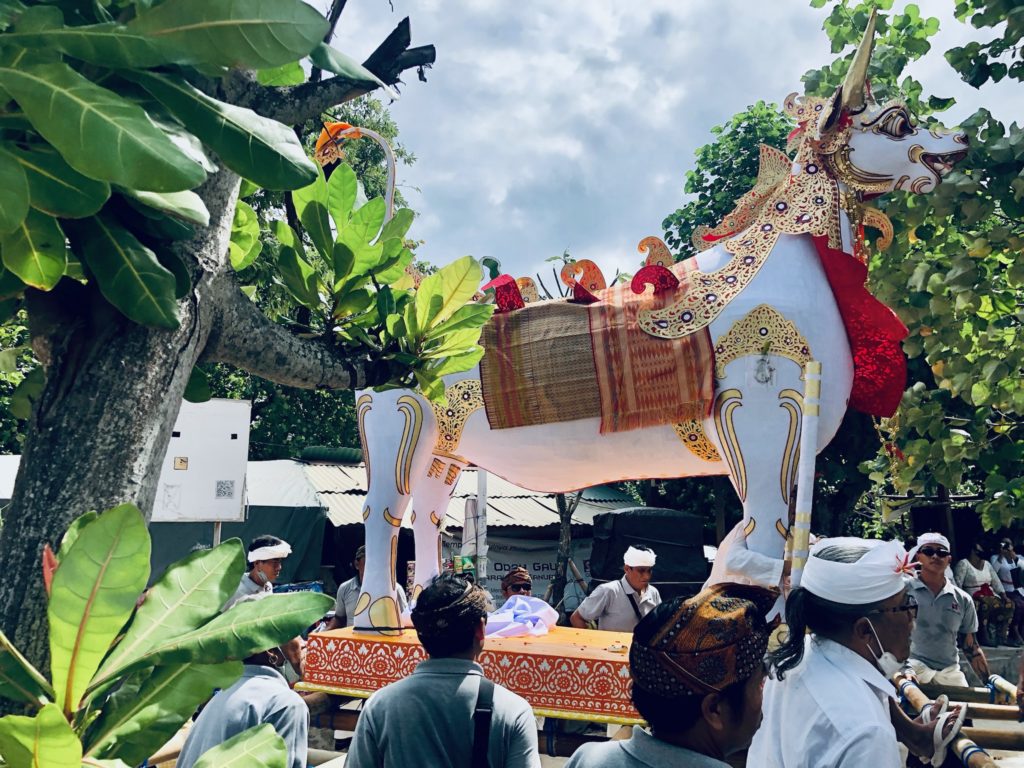
With one glance at the horse, the writer fell in at the back of the parade line. The procession snaked its way through the town and down to the local beach. At the beach, he witnessed a BIG funeral bonfire on the sand. The paper-mâché Trojan horse was actually a huge wooden bull that would hold a corpse as it was cremated (ngaben ceremony)
What’s Up with the Funeral Fire on the Beach?
According to Hindu belief, the human body is but a temporary holder of the atman or soul. After death, this soul will will find another form through reincarnation (samsara.) The cycle of birth-death-reincarnation will continue until the atman reaches the state of ultimate oneness with God (moksha.) Before the reincarnation, the atman, released by death, may go through the rough equivalent of hell (neraka) or spend time in heaven (suarga)
In the Bali tradition, this path of reincarnation is not immediate. At first, the soul or atman is still connected to the dead body. The soul hovers near its former body, sometimes in the form of a ghost. Surprisingly, the soul or ghost can haunt family members and cause serious problems. The cremation ceremonies avoids such difficulties and assure the soul’s safe passage. Through the funeral fire, the body’s five elements (earth, air, water, fire and space) are returned to their native state. The cremation is the main way to liberate the soul from earthly connections. However, merely, burning the corpse down to ashes is not enough. There are a series of elaborate ceremonies after the public burning needed to fully liberate the soul from the body. These after-fire rituals ensure that the newly released soul is returned to God.
The cremation is the core of the funeral rituals, however. Cremation is the critical element needed for a spiritually guided death. A good Bali Hindu death is the unwobbling pivot connecting life to rebirth, all of which is necessary to balance the Universe. Indeed, life, death and reincarnation continues in a never ending spiral. This circle is unbroken. A child’s birth is seen as the rebirth of a deceased relative, with ancestors returning as their own descendants. The spirits [note the plural] of a new born are still rooted the divine world of the ancestors. The early infant is taken care of by their nyama bajang, or one hundred and eight (108) spirits. Babies are treated like gods. As such, babies never touch the impure ground at all for the first 105 days after birth.https://www.nytimes.com/2017/02/18/world/asia/bali-indonesia-babies-nyambutin.html#:~:text=Belief%20in%20reincarnation%20is%20widespread,returning%20as%20their%20own%20descendants.
Thus, the most important events in a Balinese life is what happens to him after he dies — and all is centered around the cremation ceremony. The funeral is a celebrated stage in a life’s progress. No expense is spared for this great event. However, the cremation is not a grieving or mournful event like in the West. There is no Bali funeral dirge; no ”swing low, sweet chariot, coming forth to carry me home.” In contrast, the immediate family is somber, but the public crowd are generally laughing, horsing around, all in an playful atmosphere.
Death Culminates in Seaside Release
The funeral cremation is a multistage operation that may take weeks or months to prepare. The first essential step is for the family to consult with priests and astrologers to pick an auspicious funeral period. This calculation is in accord with very complicated Bali astrology rules. The blessed time period can be weeks or month in the future. That’s okay, because often the funeral can not be held immediately anyhow. Unless wealthy, the family must scavenge and scrounge to secure the funds for all the funeral events. The funeral can have fabulous costs, up to a year’s income for the family. Thus, the fund raising, elaborate preparations, and picking an auspicious astrology date can delay the ceremony for weeks or months after the person’s death.
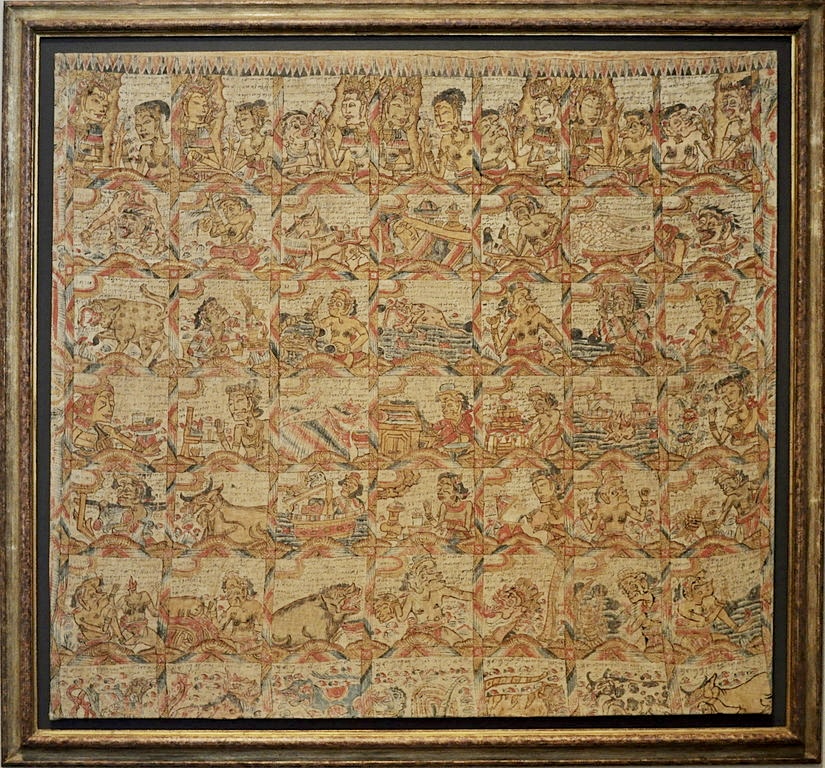
Once the date is set, every one has to help. Everyone from far and wide: every in-law, distant cousin, bastard step-child, friends, neighbors, fellow villagers — anyone who knew the deceased — all pitch in with the never-ending work. Most obviously, is the construction of the working parts of the cremation procession such as the wooden animal figure, the carrying pallet, mobile stairway, temple replicates and all the other funeral falderol – a sample of which are seen in these photographs. Then, someone has to create, store, organize and distribute the hundreds of objects and offerings paraded down to the beach, see photographs below. Other construction jobs includes temporary structures for shrines, shelter and shade along the parade route and the deceased’s home. The family compound’s open pavilions must be decorated with brocade and bunting. And that is just the easy and most visible part of funeral preparations.. The more hidden aspects includes thousands of offerings arranged in various types of containers. Offering baskets can be small, simple and beautiful; or large and luxurious; or how-did-they-do-that with only bamboo and banana leaf? Some containers are hand-made, formed from banana leaves and thin bamboo sticks. Other offerings can be in woven reed baskets or containers made from other material. The offerings themselves come in all shapes and sizes. Offerings baskets can hold food, flowers, personal items of the deceased, ritual symbols and many other objects. These offerings must by made every day of preparation without cessation. According to the leading Bali anthropologist, Fred Eiseman, ”For a medium sized cremation, perhaps two dozen or three dozen women will work all day long for several weeks just to make flower and fruit basket offerings” See below for cite to Eiseman’s work. The offerings used this particular cremation are set out below in the article section: ”Pomp and Circumstances”. The photographs immediately below just demonstrate the variety and range of offerings. Offerings are always made by, attended to, and offered up by women.
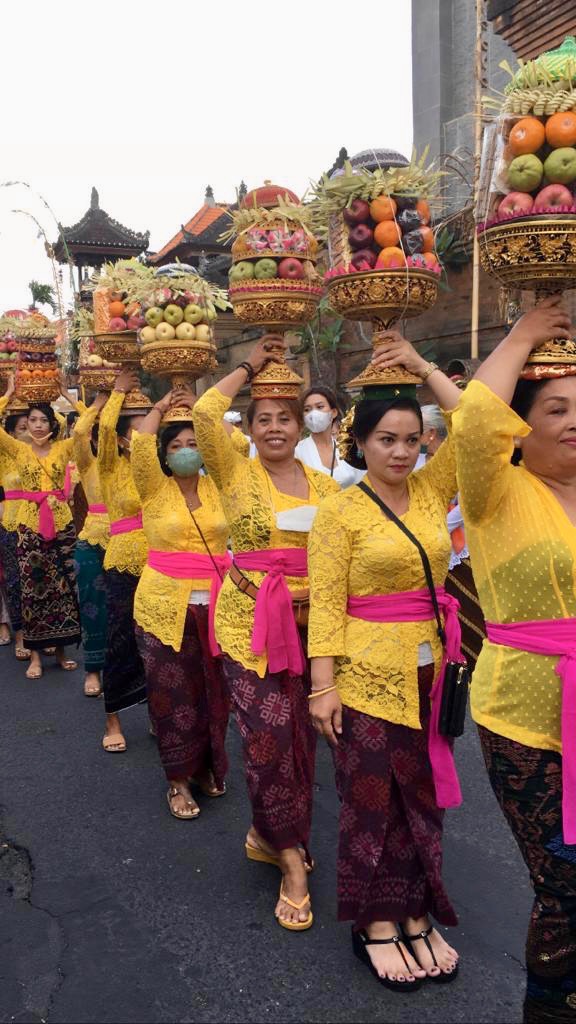
Note: The writer lives at Agustri Homestay in Sanur, Bali. Sanur is a sleepy, but charming, beachfront suburban town. Agustri Homestay is a great housing choice for all travelers whether tourists passing through town; or visitors staying a longer term. Ibu Made pictured above and right is the owner of Agustri Homestay.
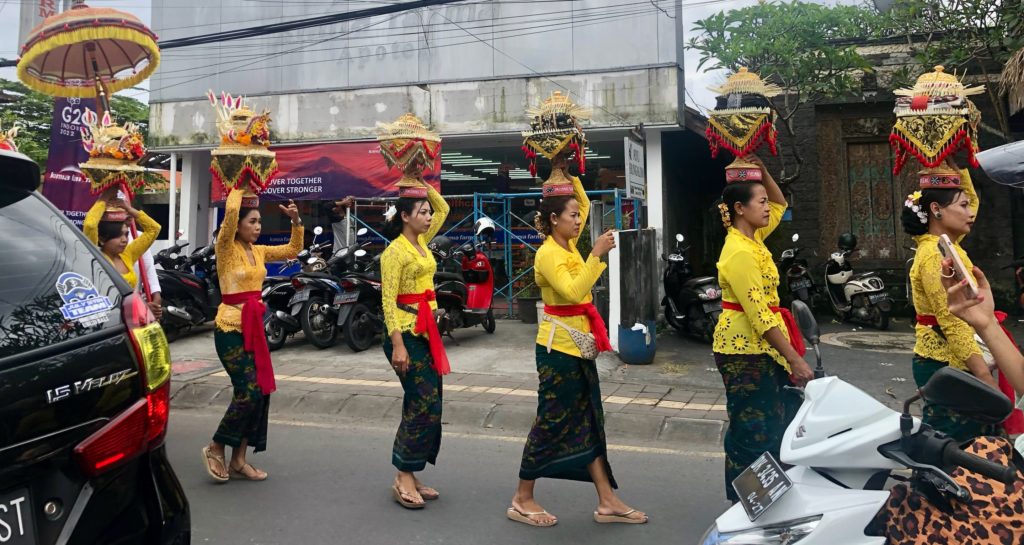
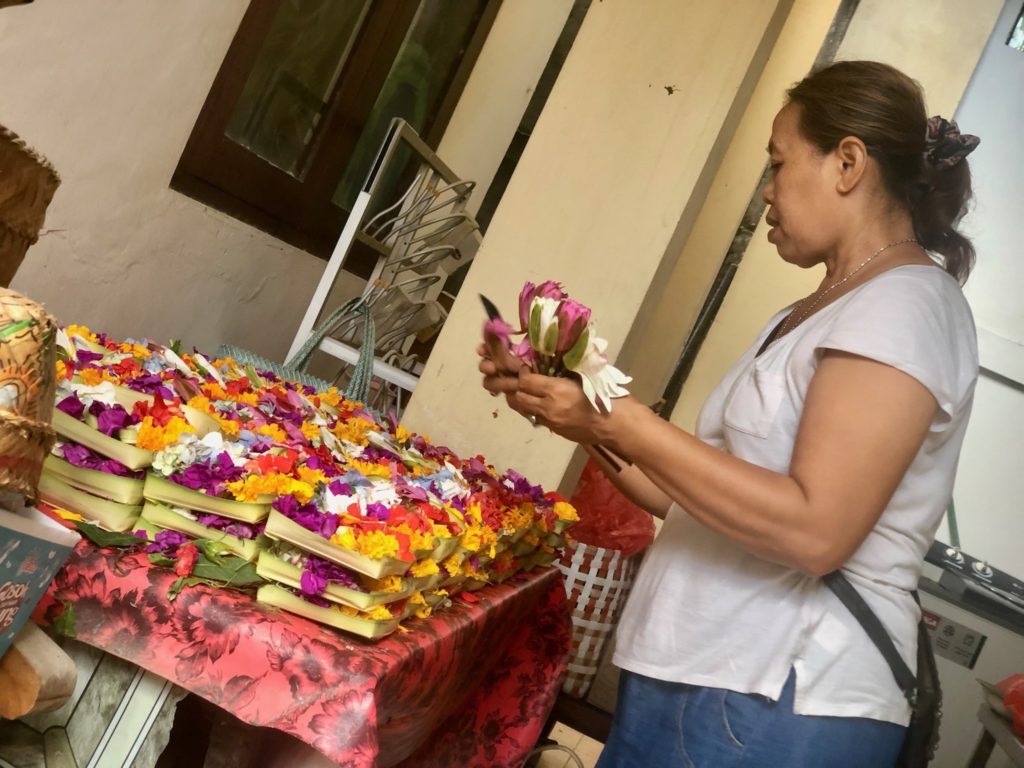
In addition to preparing offerings, cremation prep task list scrolls on almost endlessly. Naturally, the preparers get hungry. Endless amounts of food must be prepared and distributed daily to the volunteers, workers and assistants. Musicians, and dancers and security must be employed and trained to this location and situation. Hindu priests and other traditional religious leaders are retained and prepped. These religious leaders will officiate at the ceremonies and and help out in many ways. Plus, someone has to negotiate with the regular police, the neighborhood security force (pecalang) and traditional neighborhood authorities (banjar). The family will have to get and pay for separate clearances and permits from each of these authorities. Representatives from all these groups will be at the ceremony to provide security, guide the participants, and if necessary, crowd control.
All of these interlocking pieces to the cremation preparation puzzle are formed without a written master plan, a formal schedule, or official organizer. The family spearheads this immense undertaking, but there is no one person in charge. The funeral and its arrangements fall into place because that the way the Balinese have always done it.
The Pomp and Circumstance Leading Up to the Cremation
The public part of ceremony begins with a big parade though the city streets. Hundreds of people in traditional dress, many carrying fruit baskets or flower offerings, all accompany the floats and sacred funeral constructions. Everyone marches through the town and then heads to the beach.
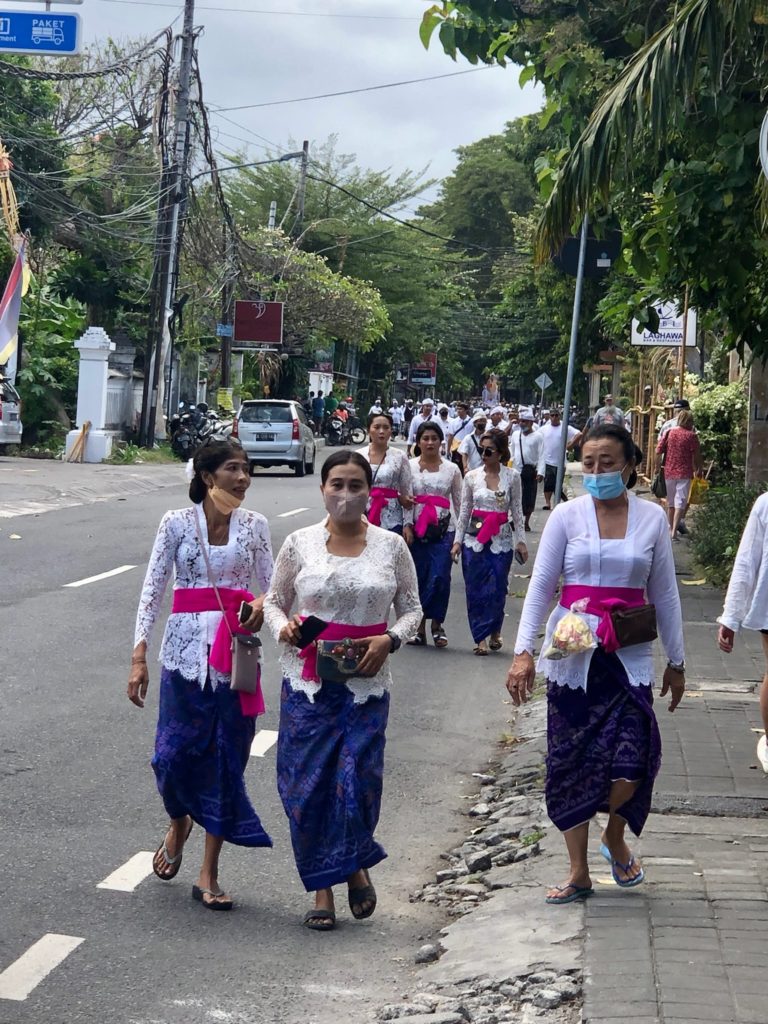

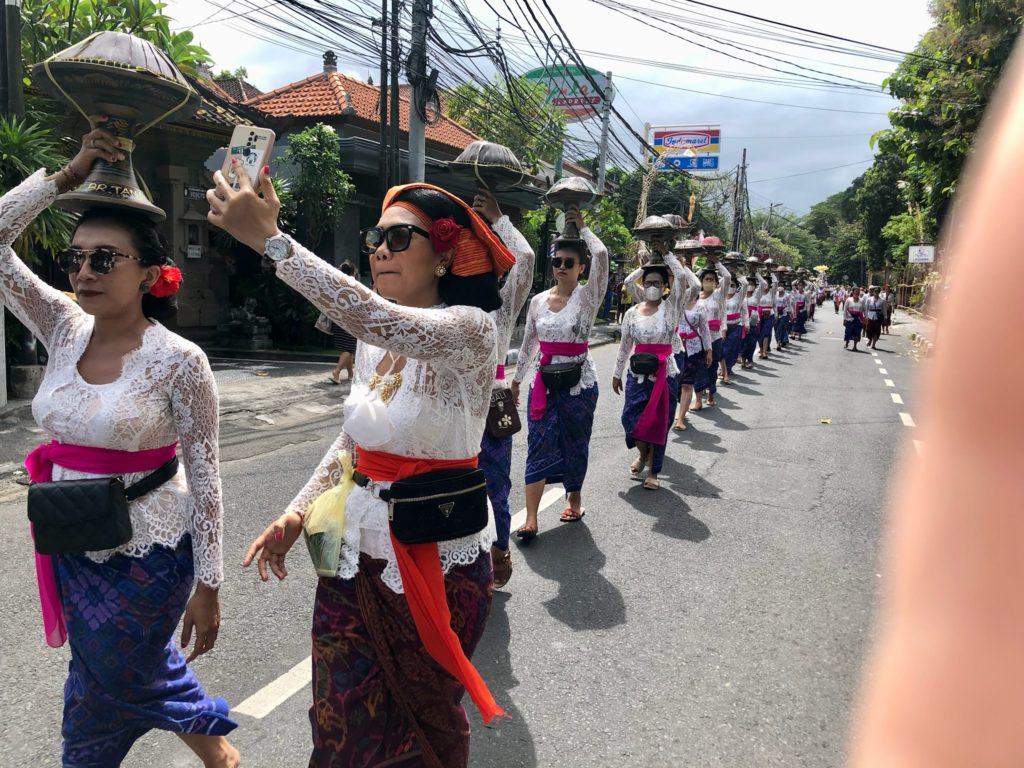
At the end of the parade formation is a high tower containing the body. It was resting on giant bamboo poles being carried on the shoulders of many men. Every now and then, the men carrying the tower would stop and turn in circles. The long parade route and the turning the corpse tower has religous importance. The living were ensuring that the continued confusion of the spirit (soul) of the dead. If the spirit can find its way back to the living, it will haunt the family. This ceremony is to let the spirit move on in peace. Here is the turning of the corpse tower below:
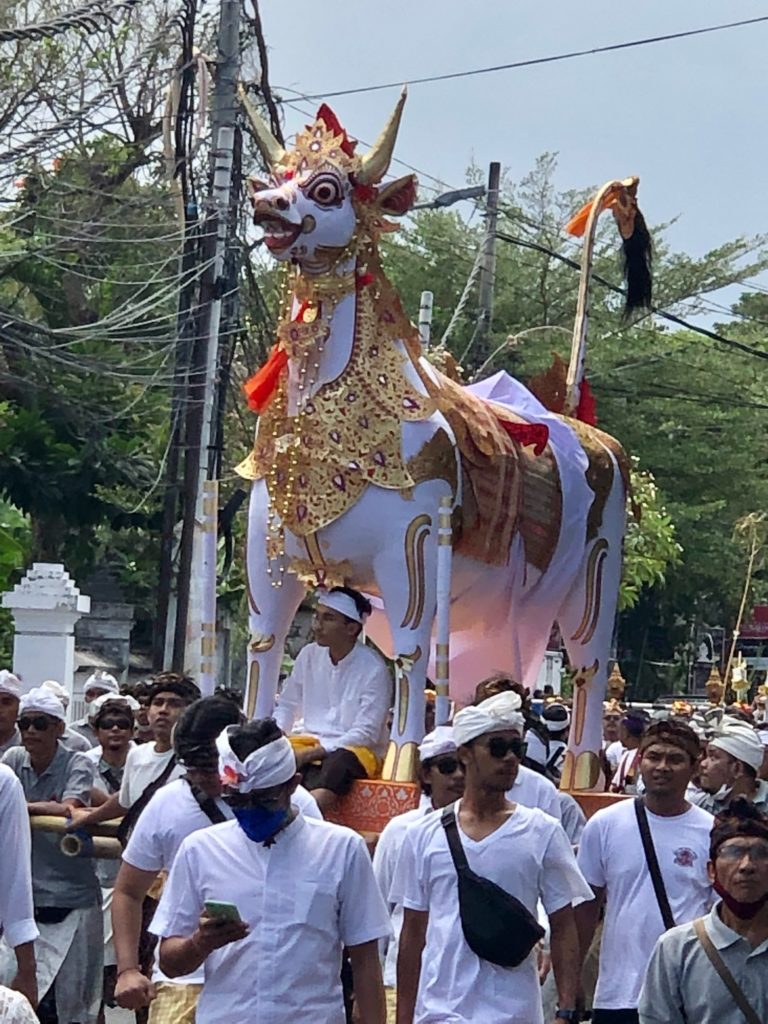
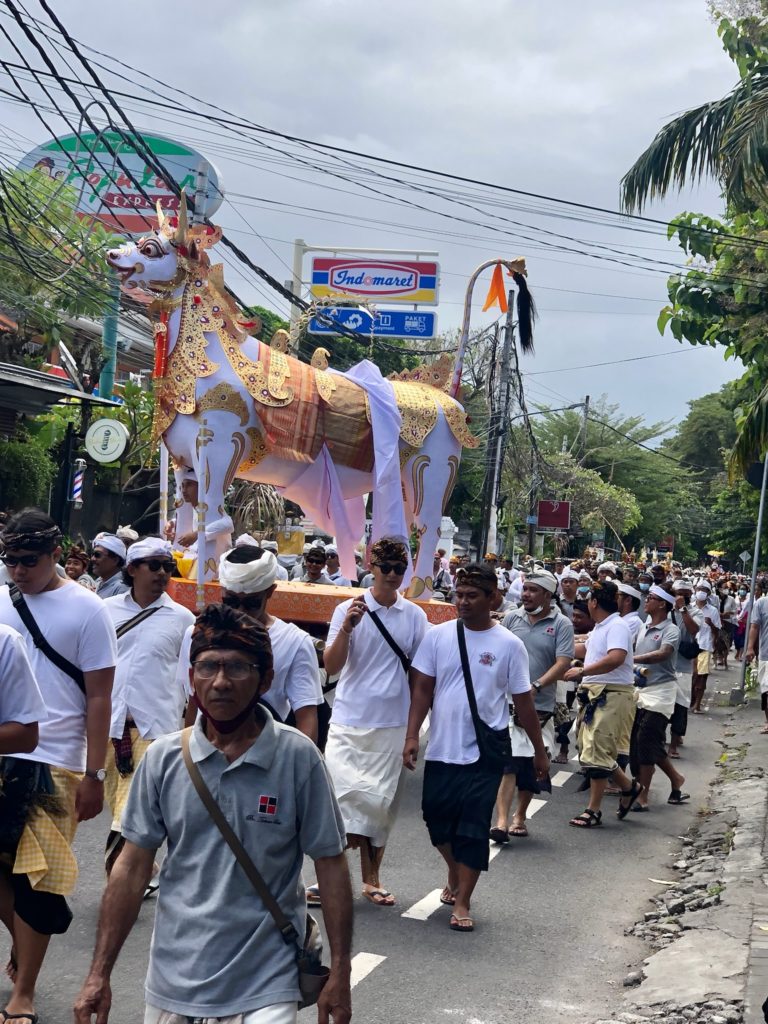
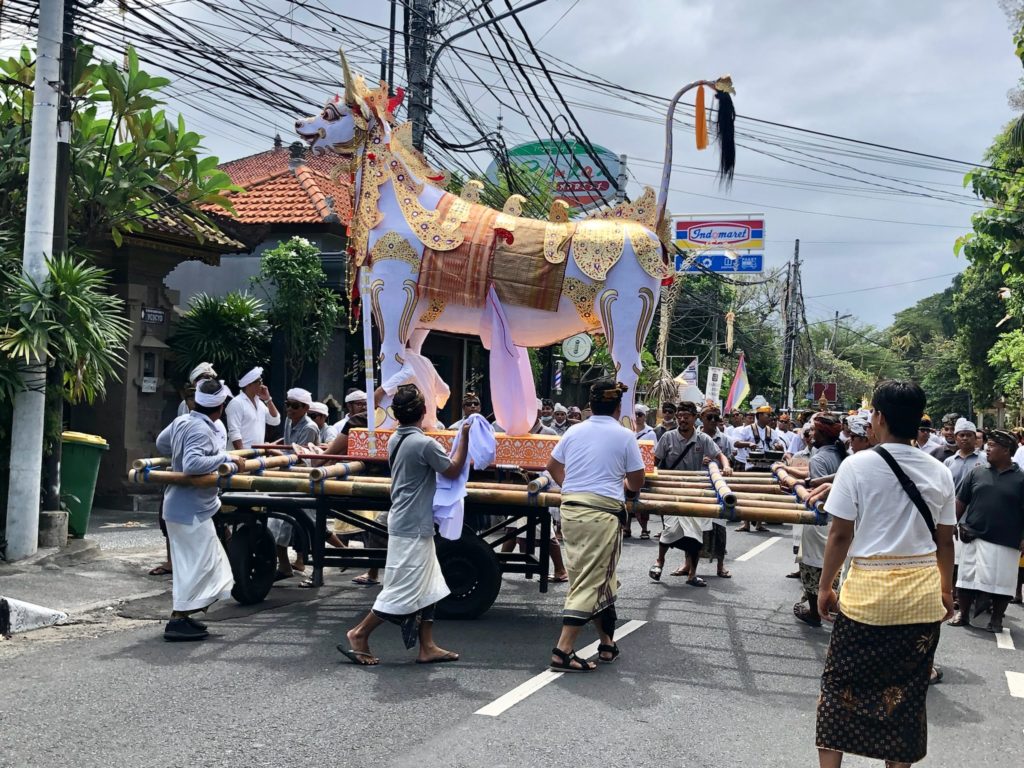
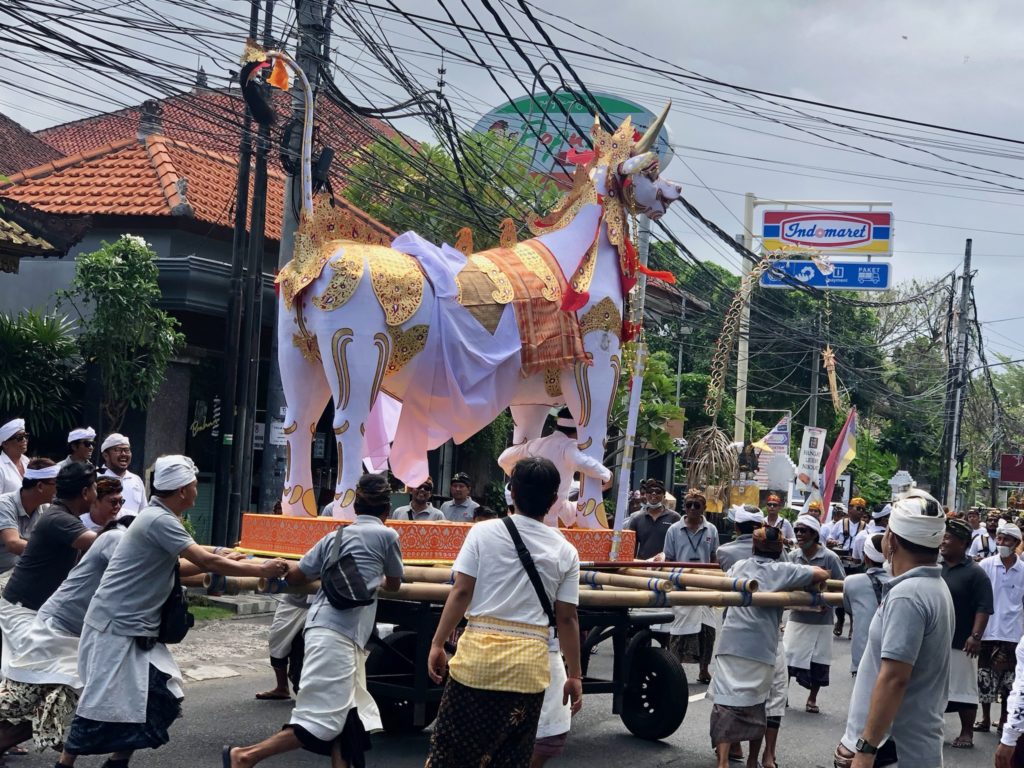
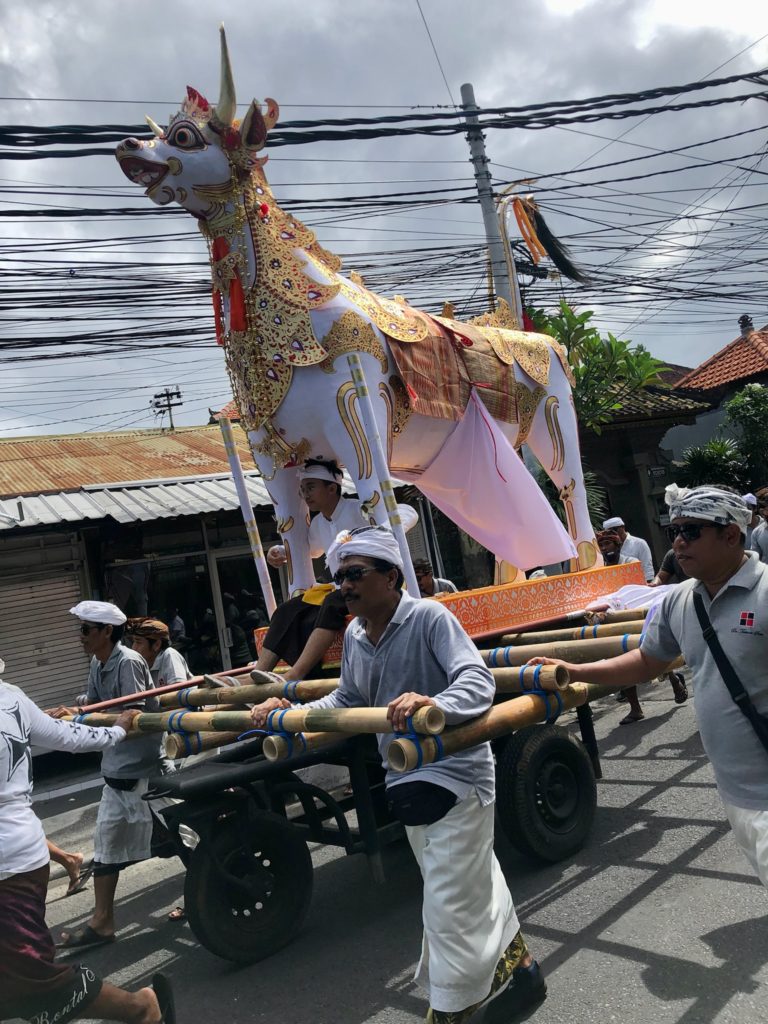
The ceremony will be started by carrying up the body into the tower (wadah) which has been wrapped in a white cloth sealed with sacred mantras. Another group of people will carry the empty special casket in animal form (lembu) to the cemetery as the place to cremate the body. The lembu here is a bull, not a horse. Obviously, this bull is white. A bull lembu is used for the funeral of a wealthy or highly respected Hindu. A white lembu signifies the deceased was female; a black lembu is reserved for males. The bull lembu and all of the elaborate display show that this funeral is high status Hindu woman.
Once the casket has arrived, a line of women with offerings on their head will follow the crowd along with other mourning family or relatives.
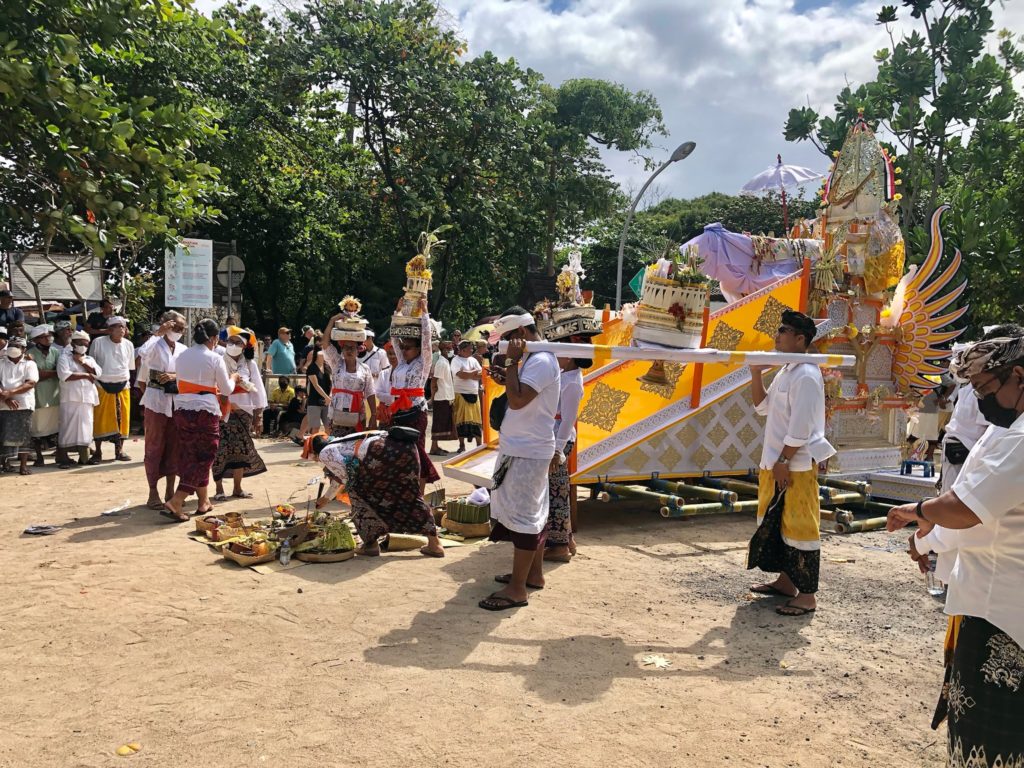
The next procession will be the stretching of a long white cloth known as “Lancingan” from one end of the tower down across the sea of people to the coffin carrying the body. After the coffin has been laid down on the special pavilion under white sheet roof, a family member will open it through the back part using a special sacred dagger. Deceased bodies or bones will be placed inside the lembu (new casket) together with some clothes, offerings and accessories.
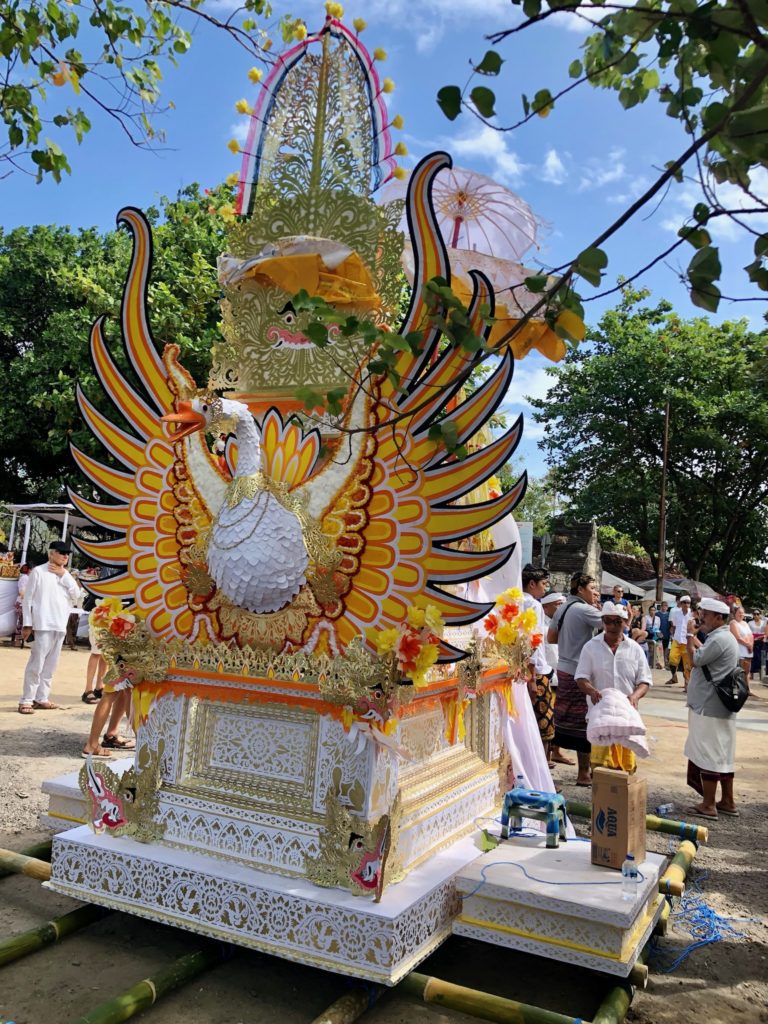
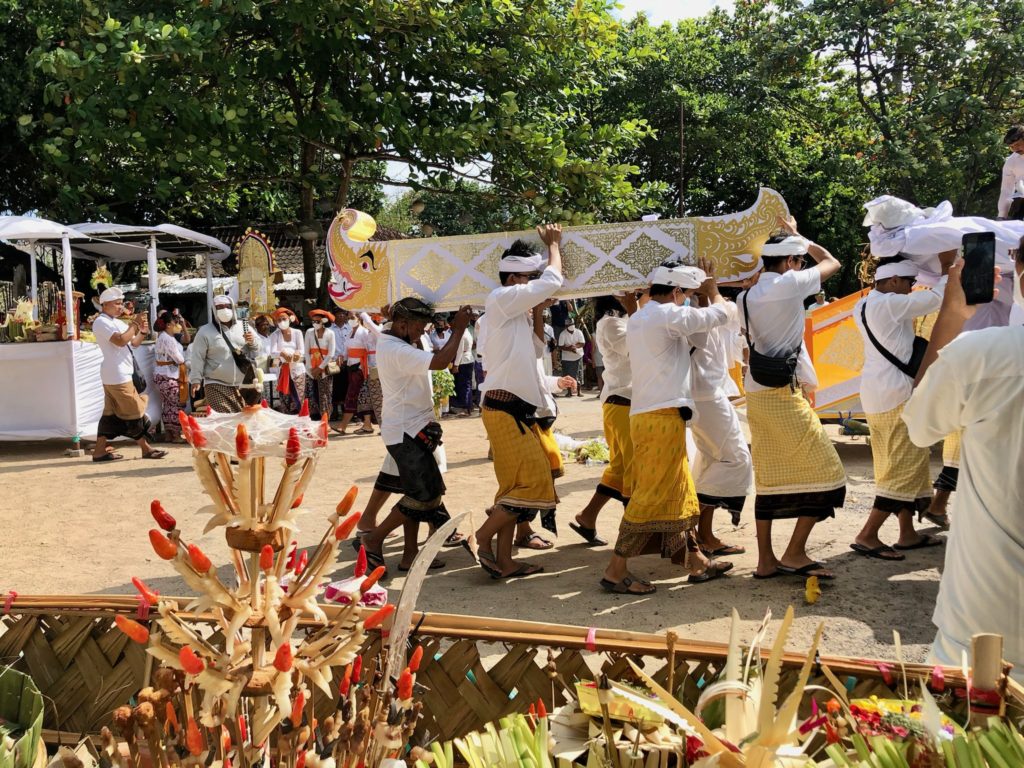
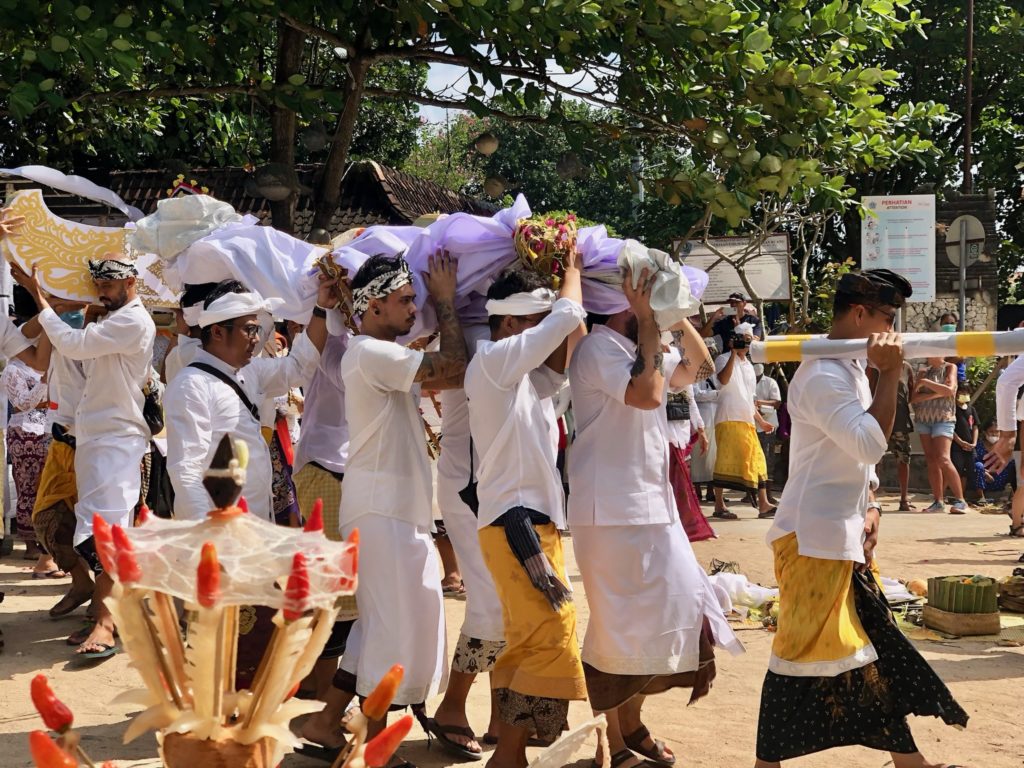
The family will take another final closer look, and when everything is ready, the fire will be ignited led by the high priest using a torch that has been blessed.
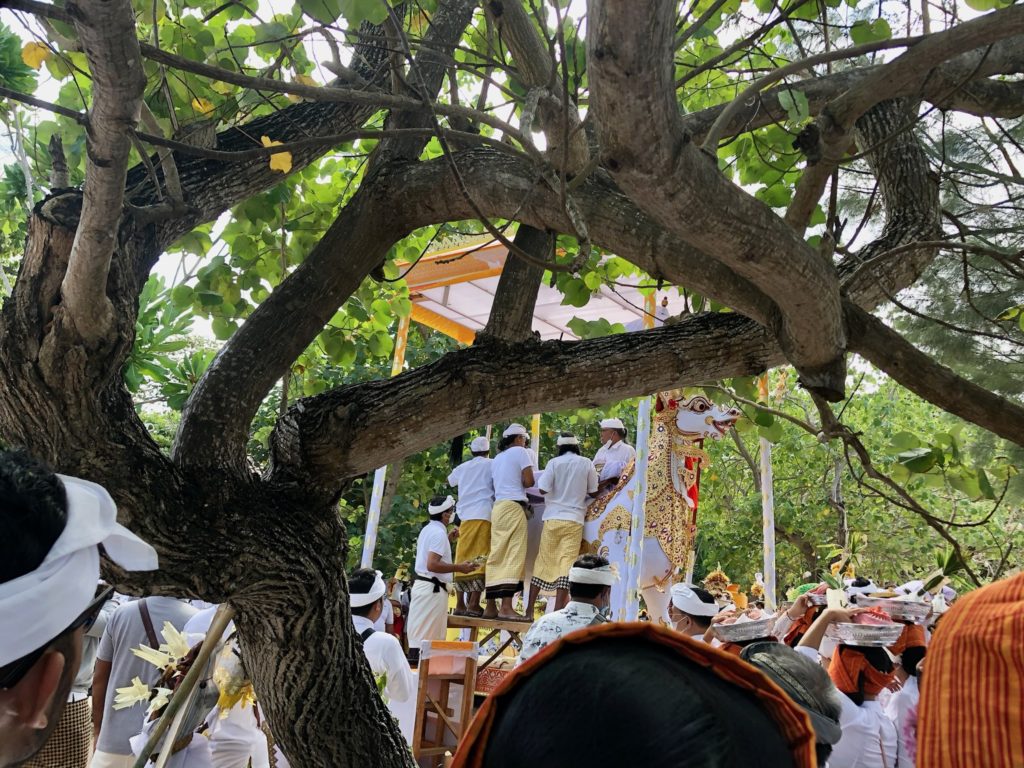
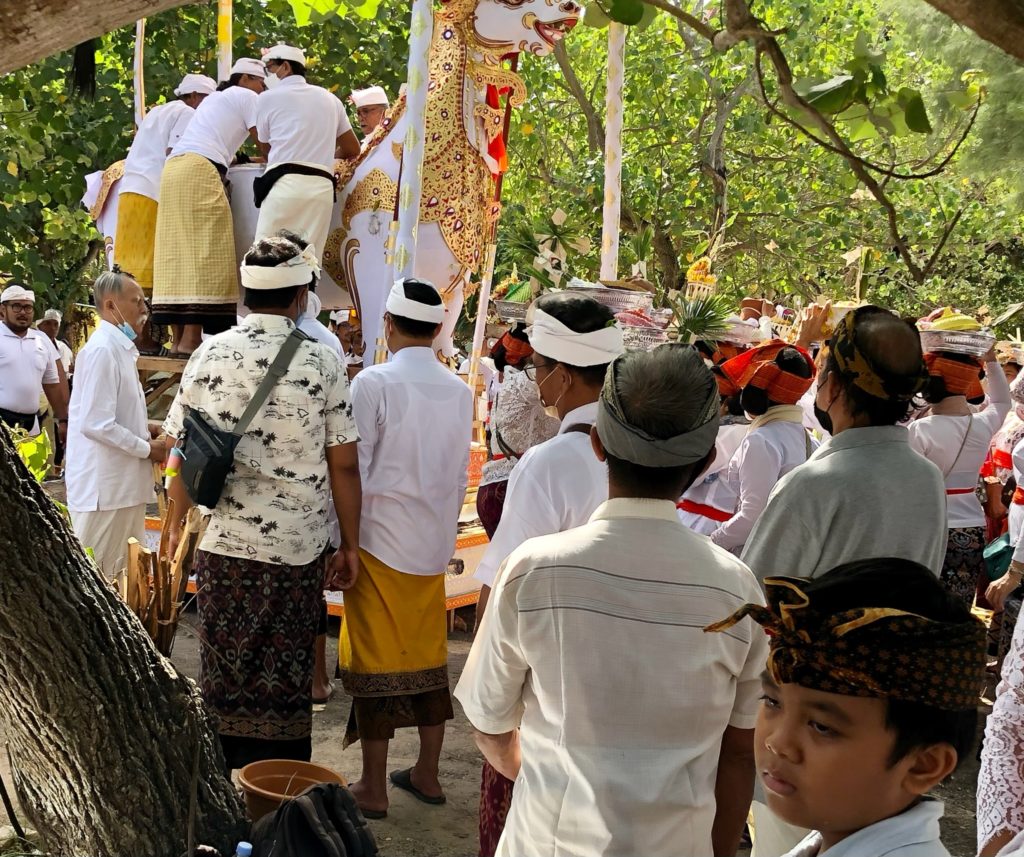
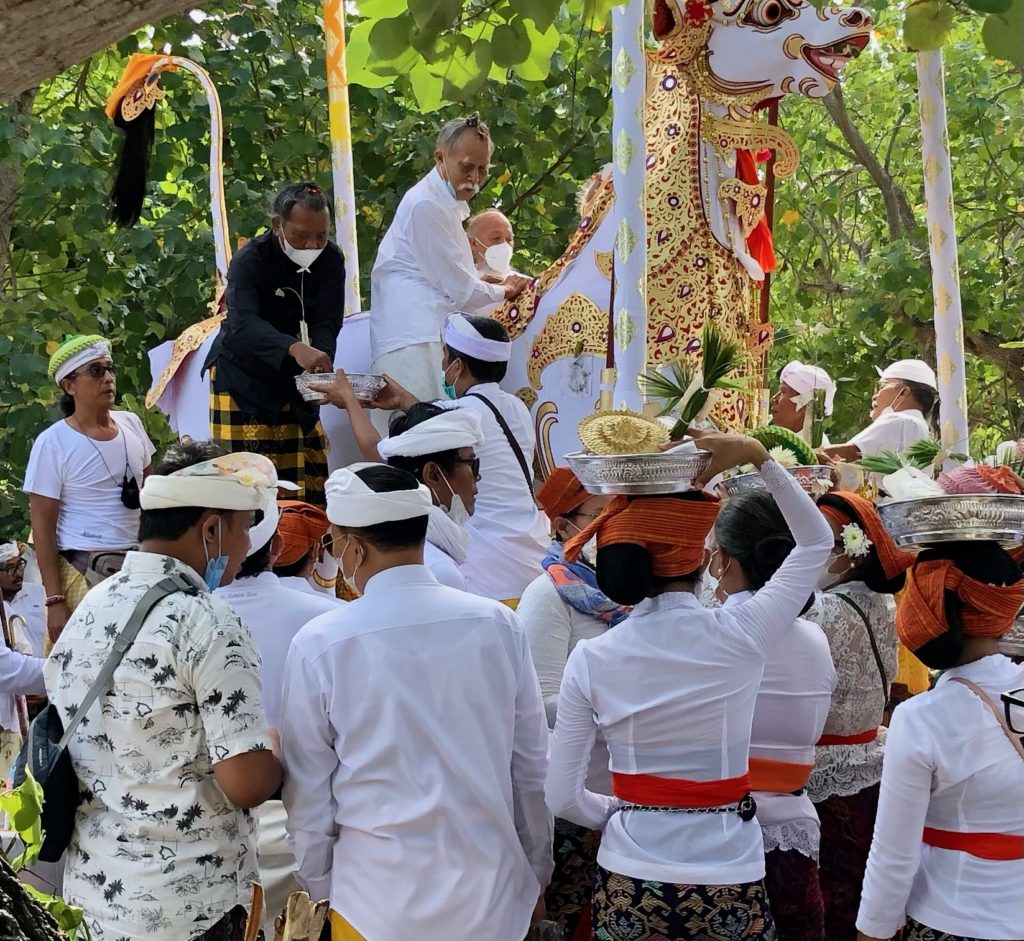
The family and Hindu Priest look on as the cremation takes burns the corpse of their loved one:
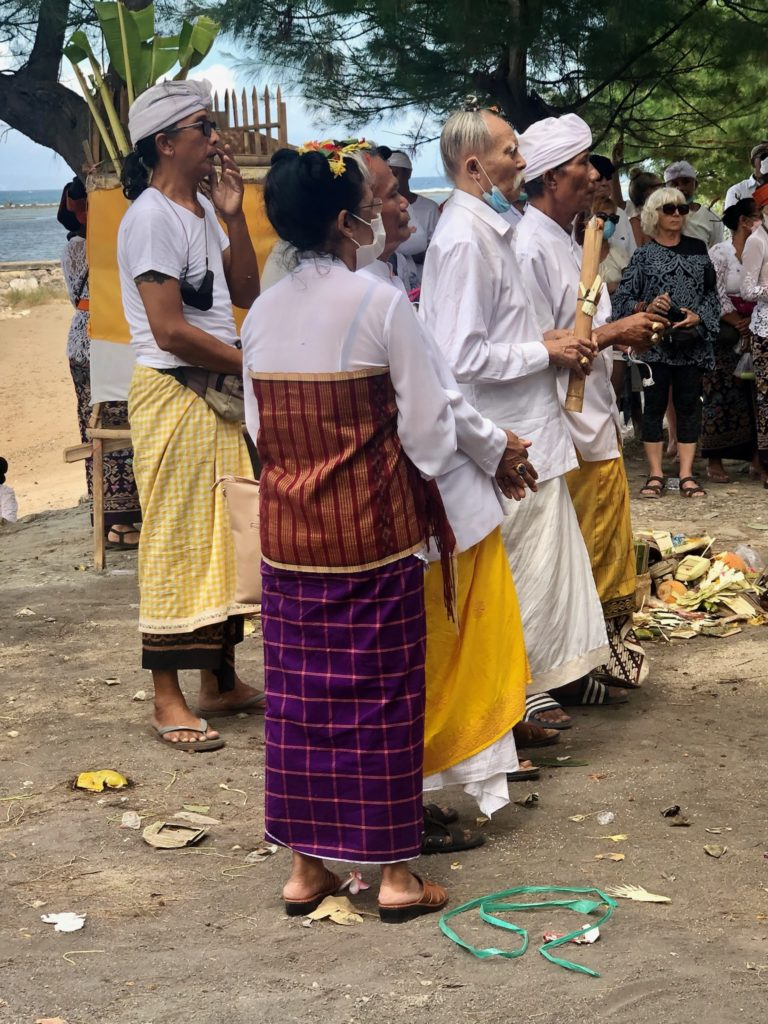
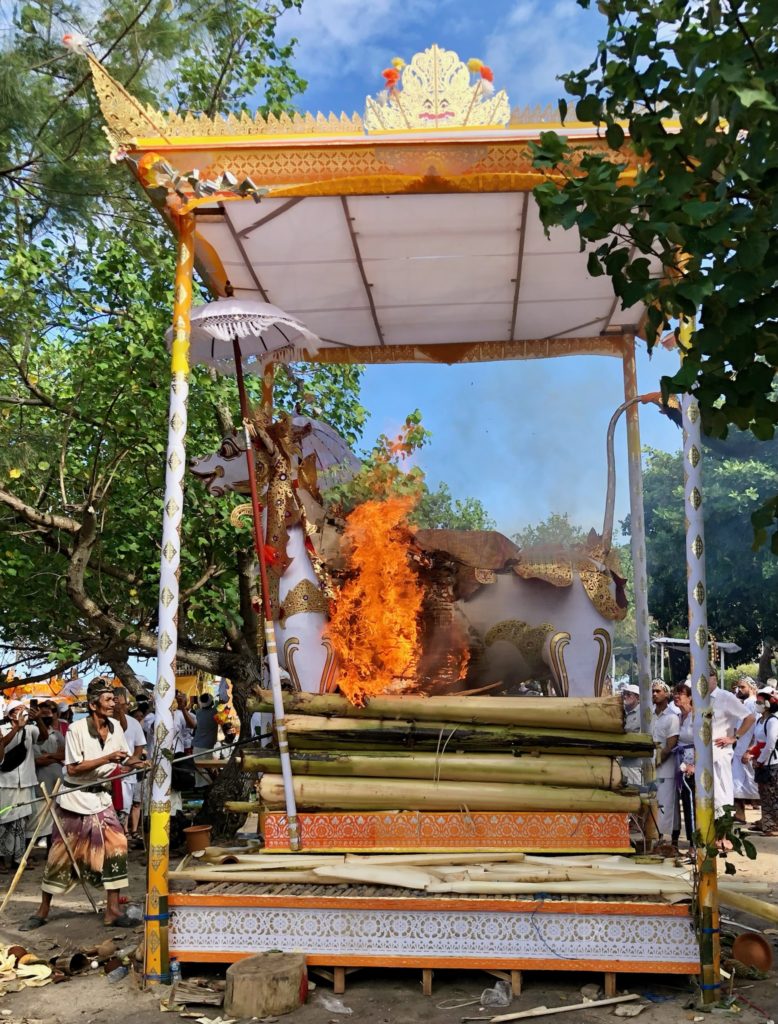
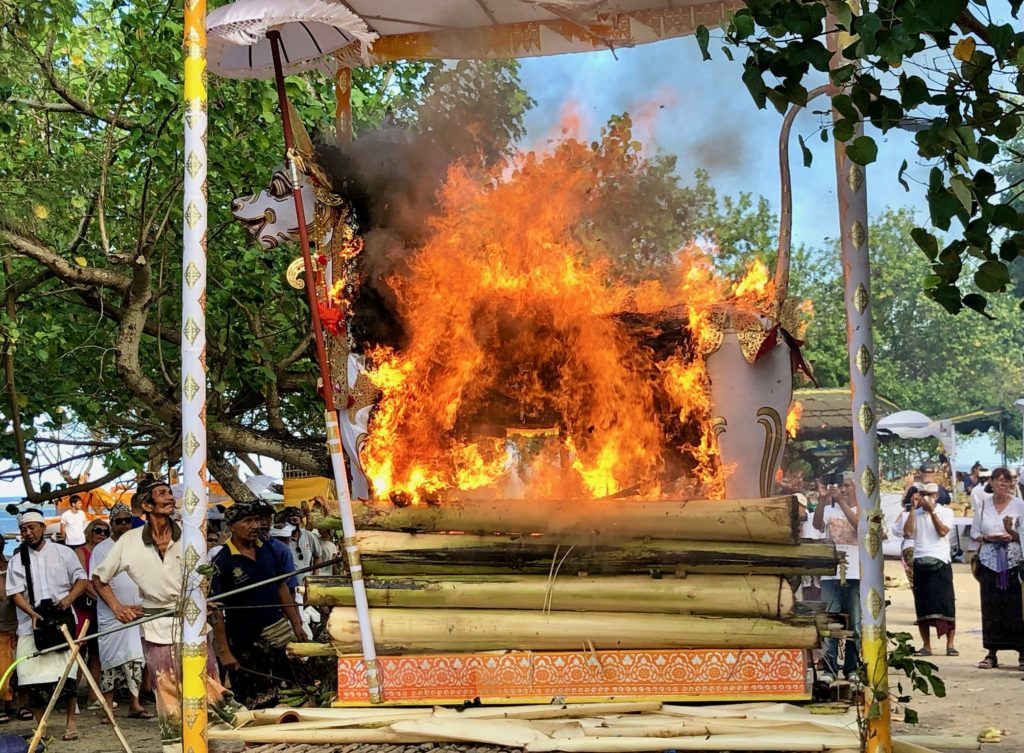
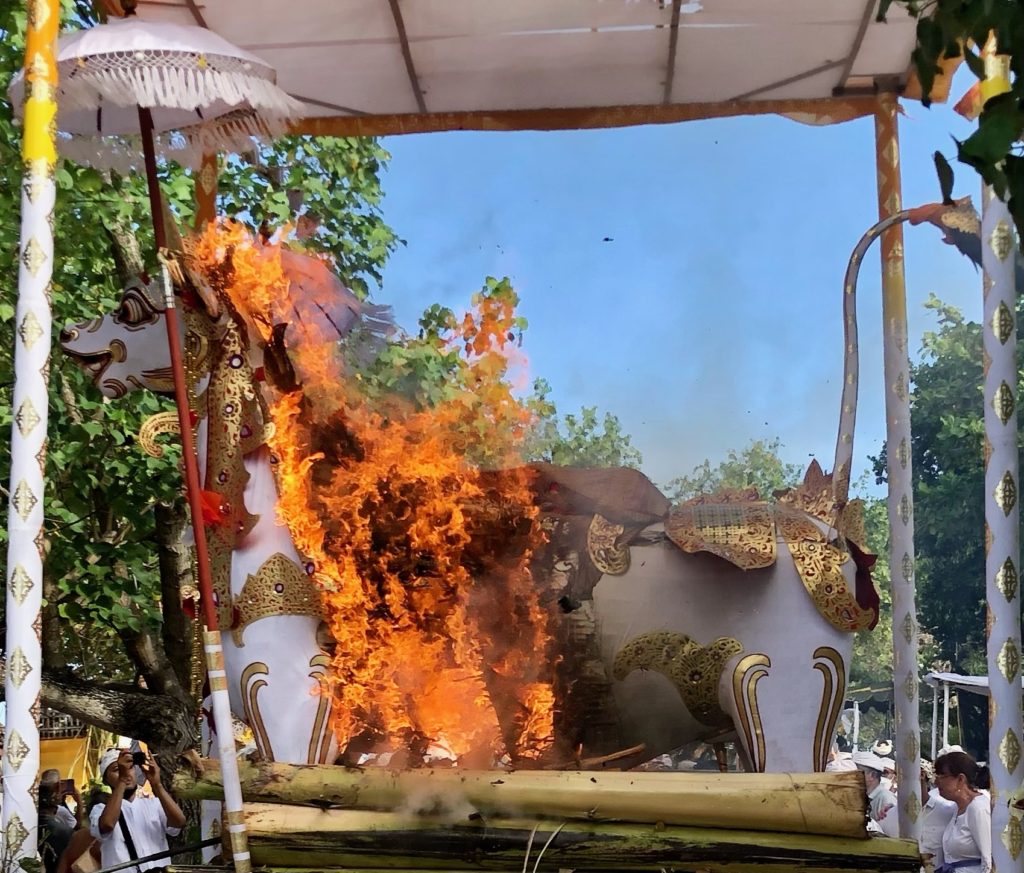
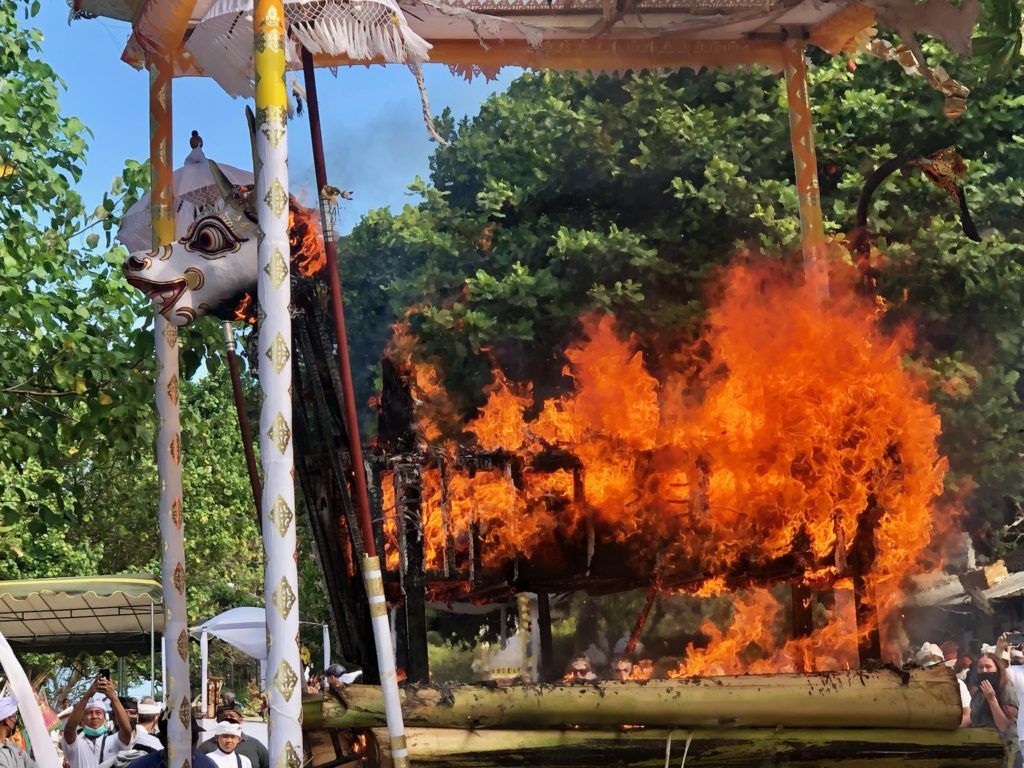
When the fire has gone out, the family will collect the ash and bone. These remaining will be wrapped in a white cloth or a container made from a yellow coconut. Meanwhile, the priest will start to chant a sacred mantra and ring the bell to help release the soul to heaven.
After the priest finishes his last prayer, the family will carry the ashes on their head to send it to the sea. I have also read that: After twelve days, the family returns to collect the ashes of their loved one. The ashes are gathered into a coconut shell, which is then released out into the nearest ocean or lake. In any case, spreading the ashes in water is the body’s final return to the earth.
A Funeral Festival of Song and Dance
Perhaps surprisingly, the funeral goers commonly laugh, chat, and joke during this whole event. The general merriment celebrates that the deceased’s soul is on its way back to God. Naturally, this huge public celebration is accompanied by all sorts of song and dance. The kettle drum band below is being wheeled on the parade route to be unleashed for a seaside funeral performance.
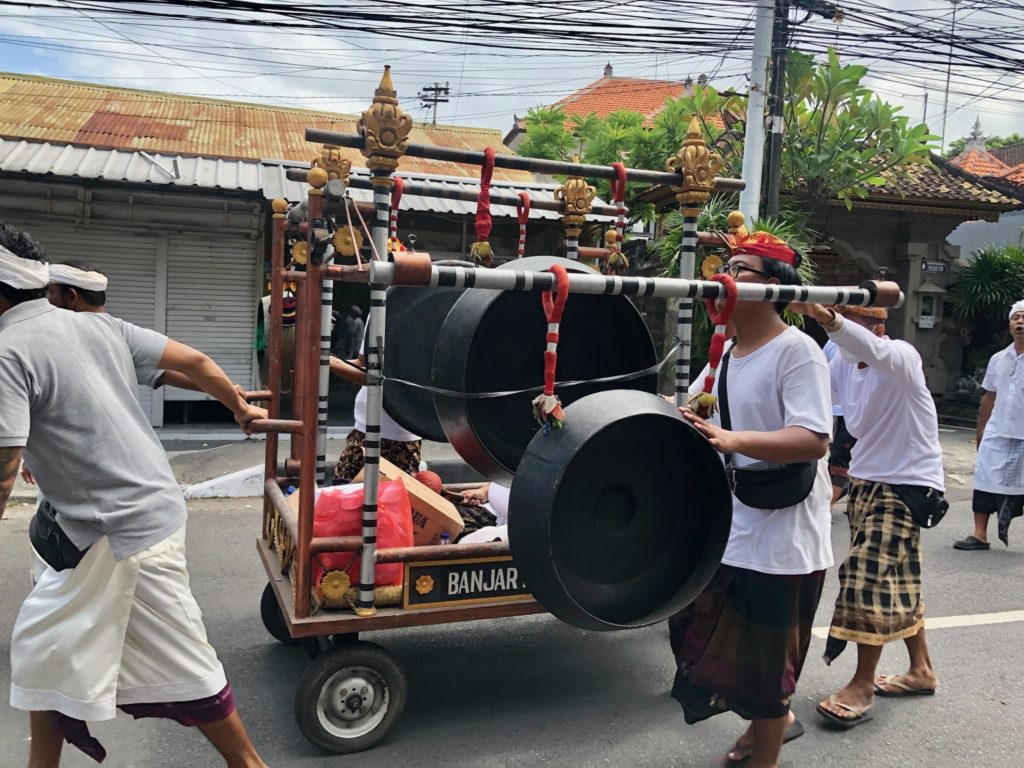
Below Left: a chant and drum circle. Right: traditional orchestra performs for the baris gede dancers. This assemble has some unique instruments only used for funeral ceremonies.
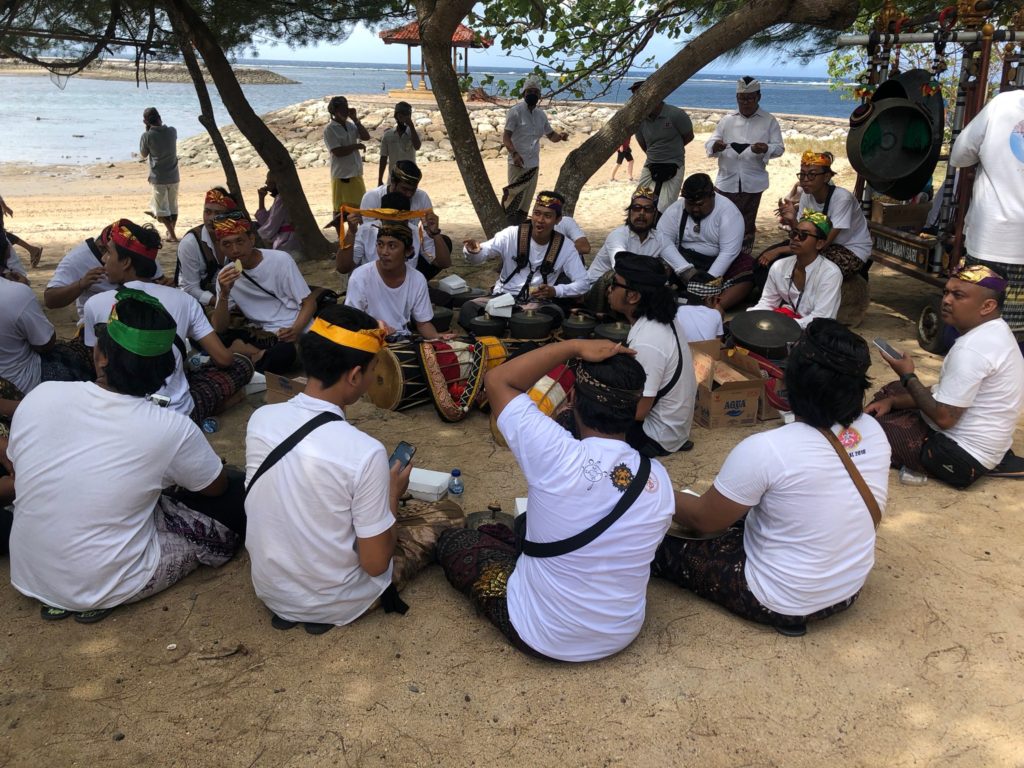
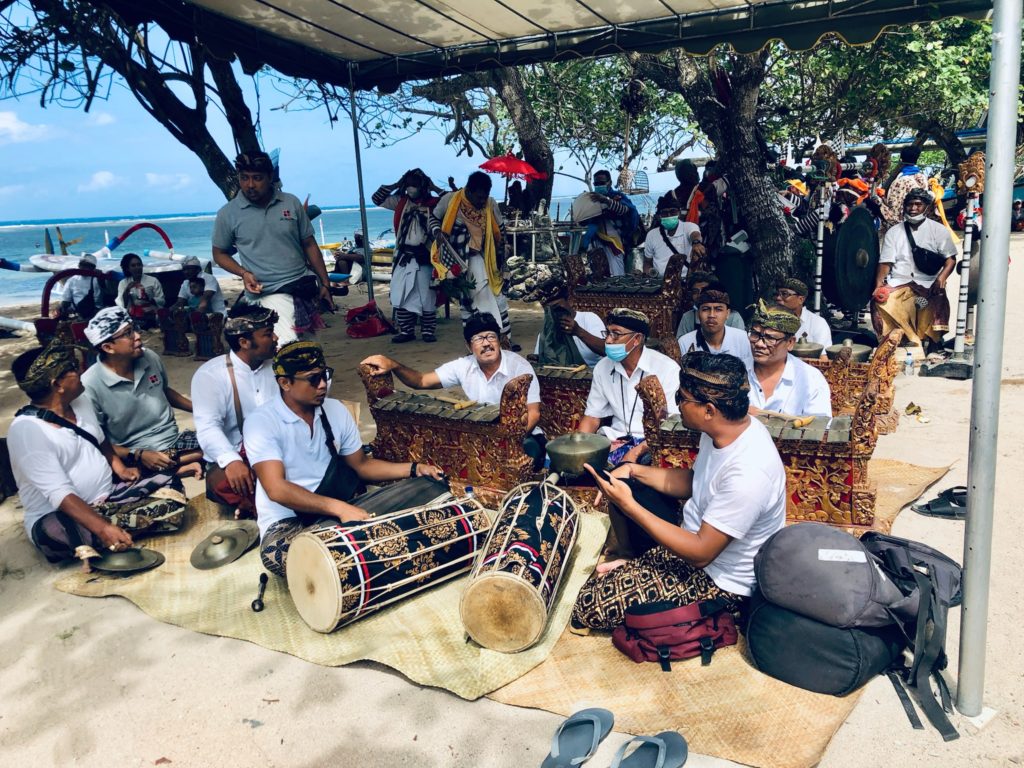
There are many types of baris dancers and they all embody the warrior tradition. Below are the baris gede, one of many military style dance group. The baris gede use their weapons, dance and song drive away evil spirits so they can not interfere in funeral events. The dance starts with baris gede picking up their weapons (spears and staves) and dancing in a march formation.
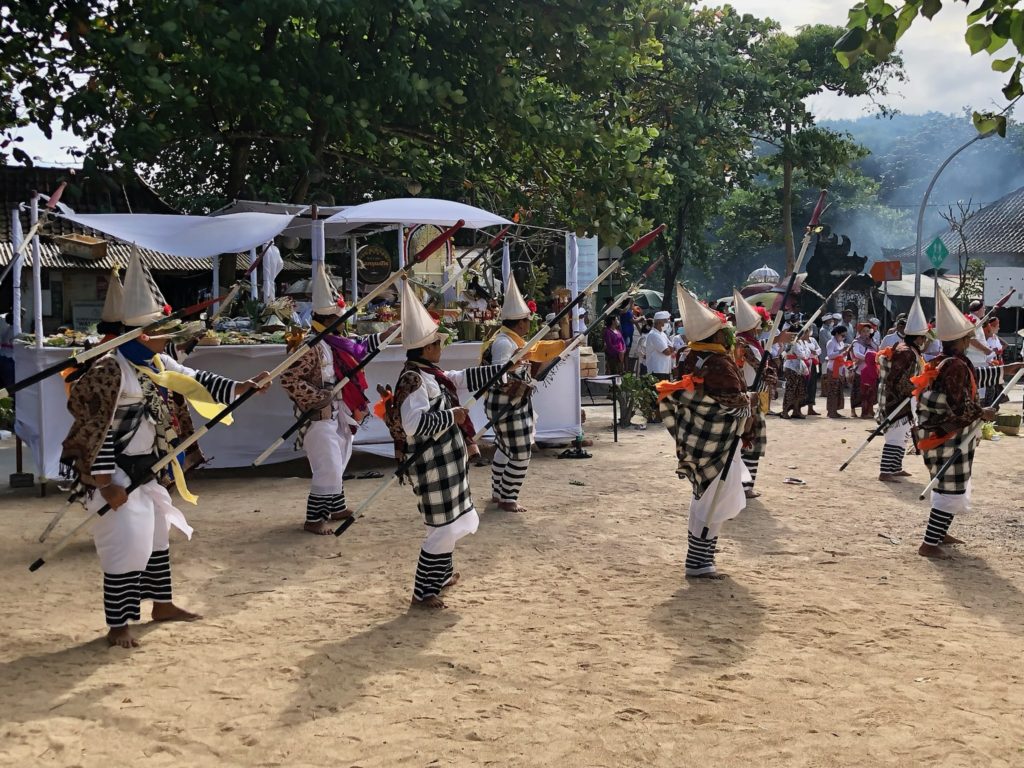
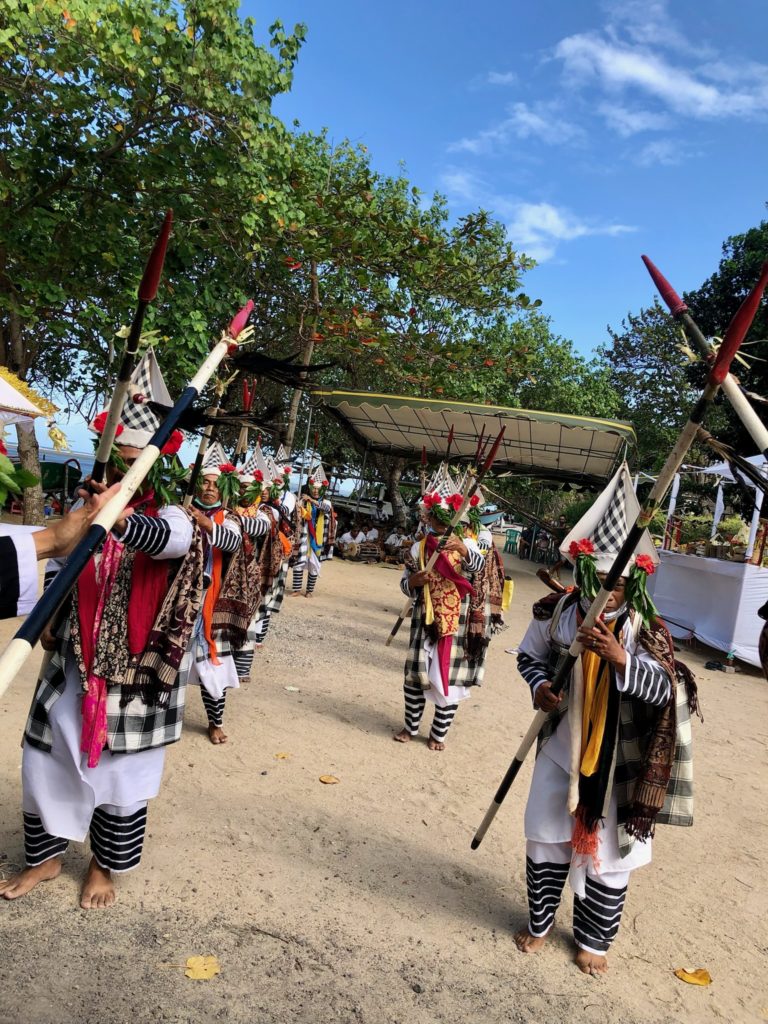
The baris gede then perform their martial dance parade.
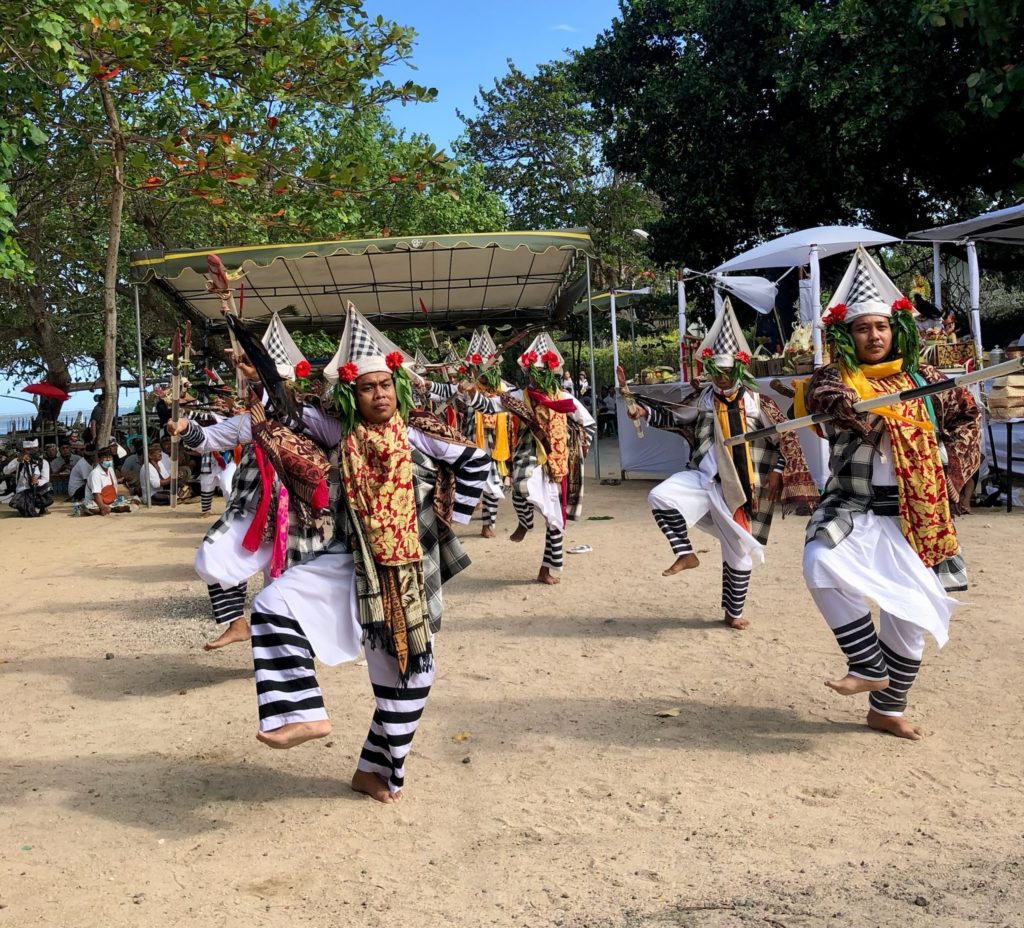
The baris gede finale is to whirl around and salute their leader. Then, they face forward and march in file to exit with their weapons held high.
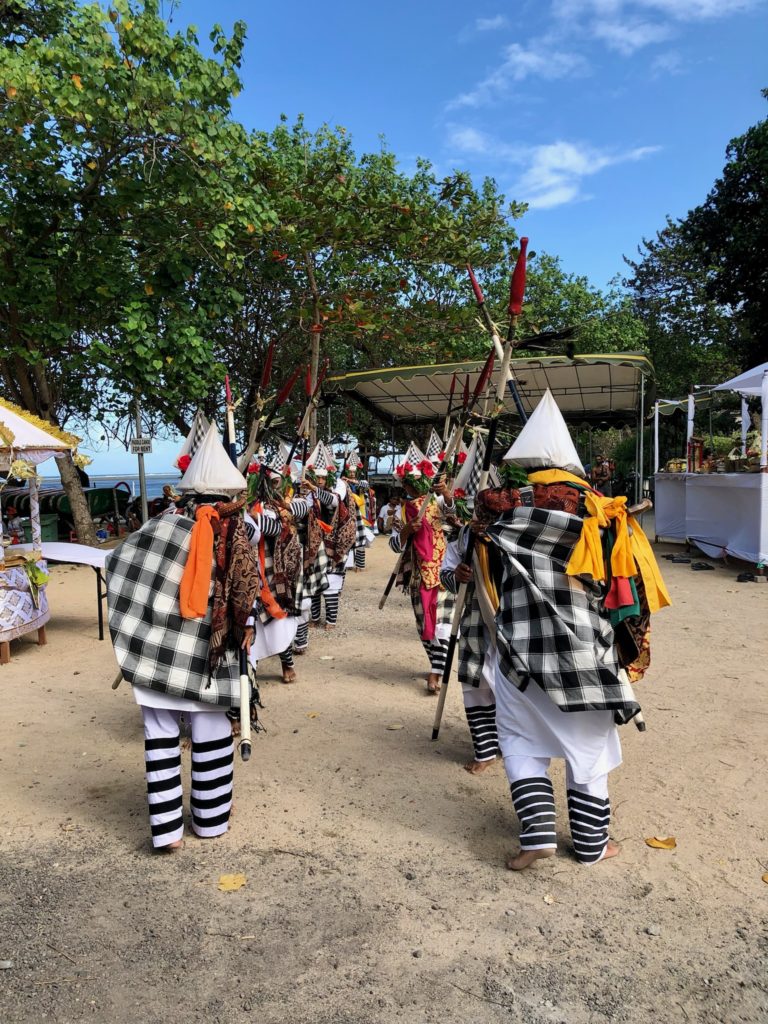
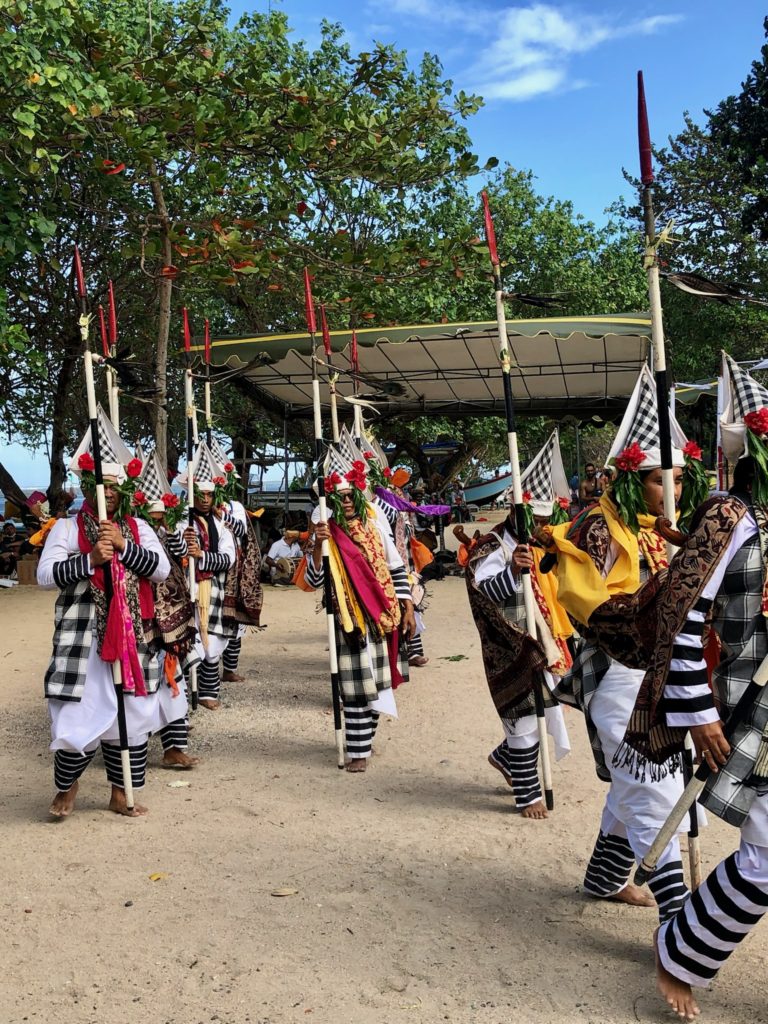
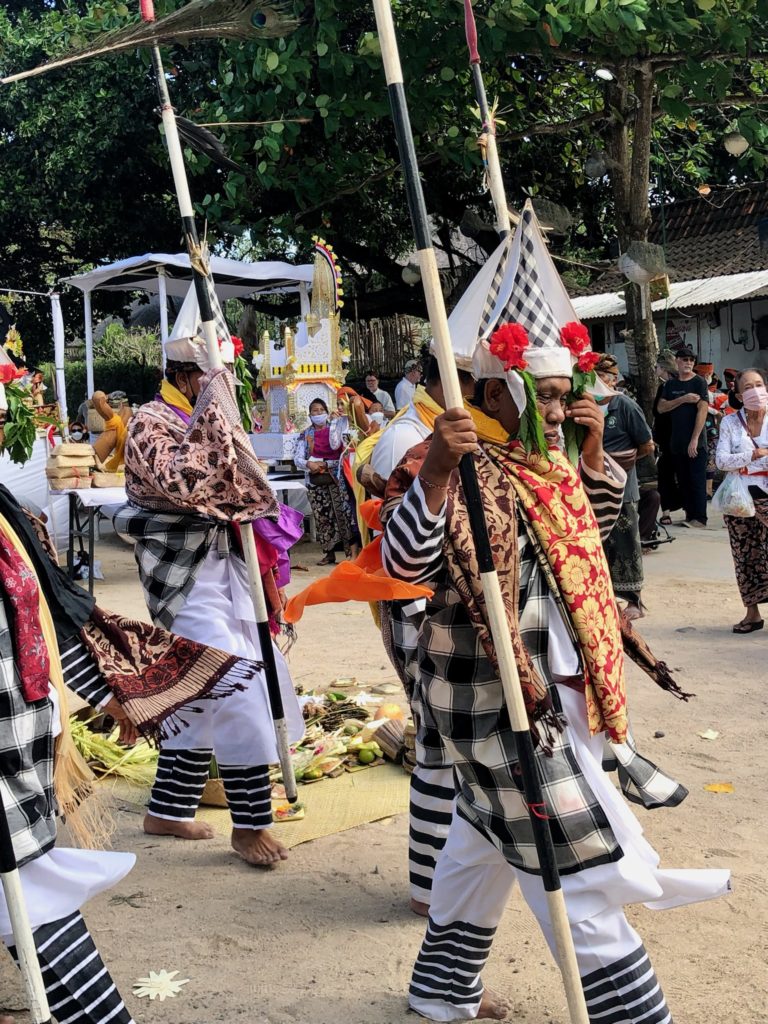
With the end of the baris gede dance, the public funeral is over. However, the priests, officiants and family have an extended set of after-care rituals to ensure the souls direct return to heaven. The most significant event takes place twelve hours after the cremation is finished. The priest and family collect the ashes and spread them on the sea; or if an inland ceremony, spread the ashes on a nearby river.
A Baris Dancer Pops Up Again – Surprise!
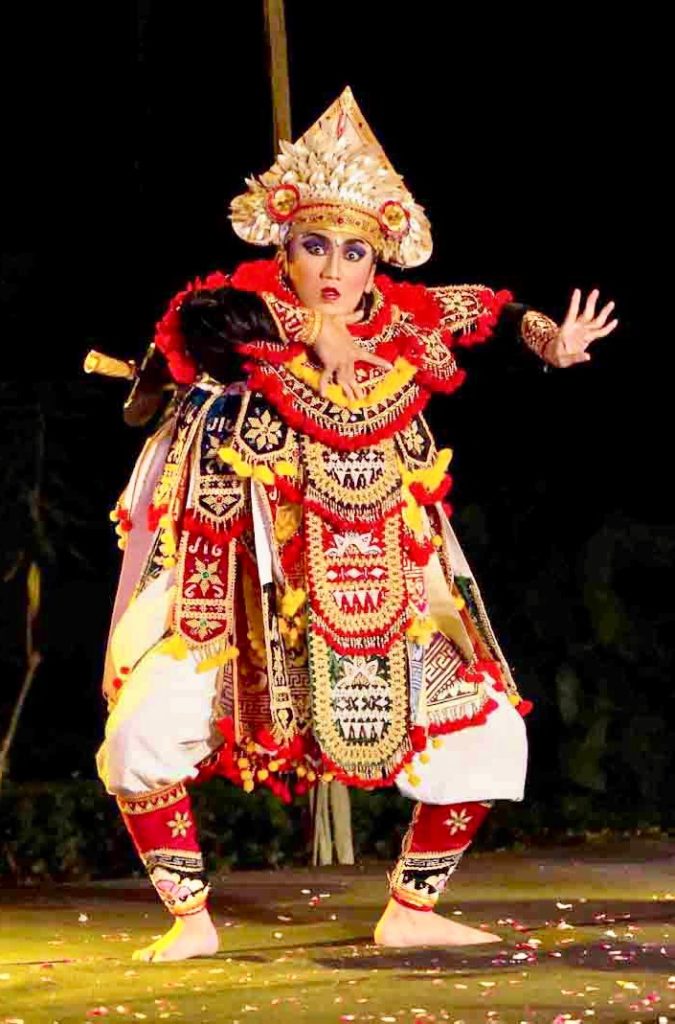
The baris gede perform to protect the activities of the funeral ceremonies. However, there is a never ending parade of other baris dancers with an array of wild styles. Hard to believe, there are over thirty different types of ritual baris dance groups. One common element shared by all baris is that the dancers imitate warrior movements.
A Full Moon Ceremony Complete With Baris and Legong Dancers
A few days after crashing the cremation, the writer was bopping down the same street. This time, he ran smack dab into a sidewalk plaza filled with Hindu commotion. There were construction crews, performers, Hindu priests, assistants and workers of all kinds. All were creating a temporary temple for a public purnama, a full moon ceremony. This purnama ceremony included a gamelon orchestra, a solo baris dancer, (baris tunggal) and standard female Balinese dancers (legong.) This writers, along with many other passerbys stayed to watch this purnama ceremony made public. This public ceremony was a surprise to many as the purnama ceremony is normally carried out in neighborhood temples or at home temples. Note: EVERY Hindu home must have a family temple, ranging from simple to extravagant; in fact, even Bali hotels have Hindu temples within the facility.
As to the baris dancer, this description is ripped off from Wikipedia, Baris Dance: ”A baris tunggal dancer, is a baris dancer who performs on his own. At first, as he takes the stage, the dancer’s movements are studied and careful, as if he were seeking out foes in an unfamiliar place. When he reaches the middle of the stage, hesitation gives way to self-assurance. He rises on his toes to his full stature, his body motionless with quivering limbs, he whirls on one leg, his feet tread the ground to the tumult of the gamelan, and his face renders the storm of passions of a quick-tempered warrior.”
As the writer watched all agog, this solo martial art performance unfolded. Expand the pictures and catch the Hindu Priest sitting at the temple altar — the guy with the huge crown:
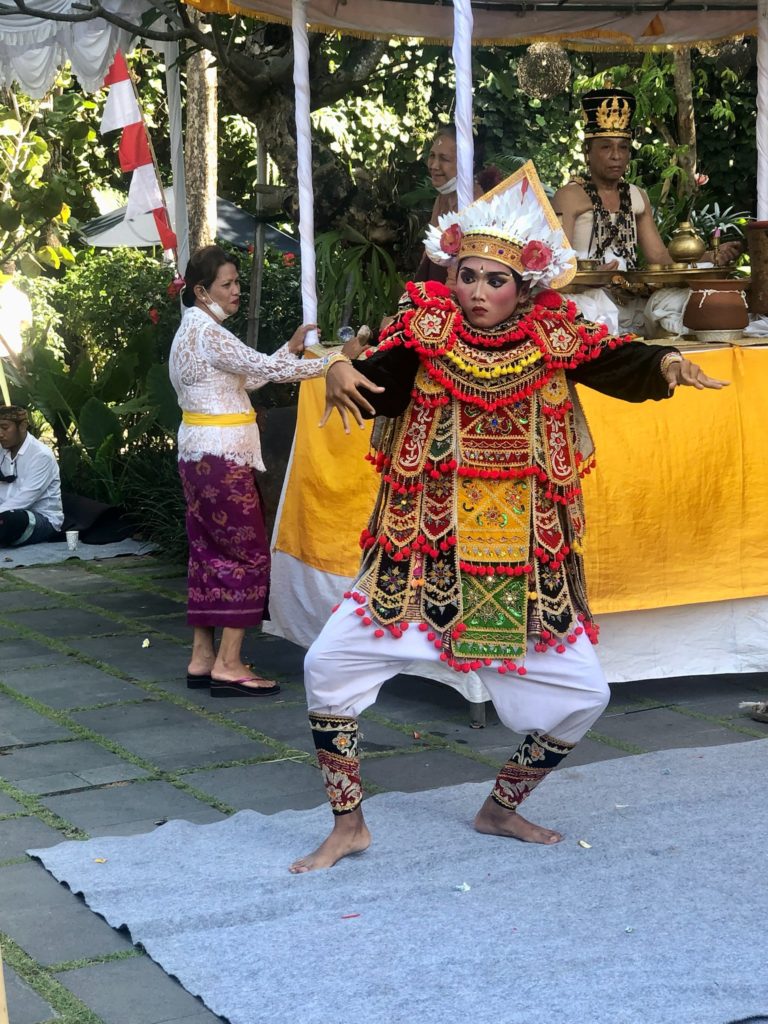
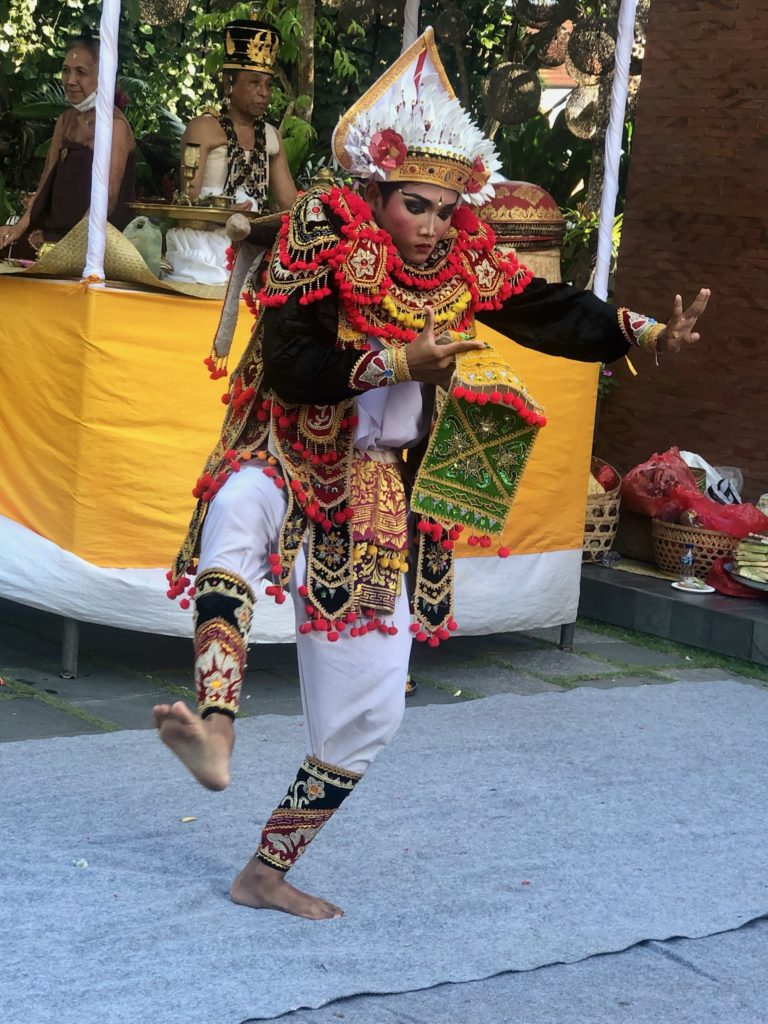

The Baris tunggal scared the daylights out of this writer. He was followed by the traditional female legong dancers. The legong dancers performed their charming, but symbolically charged, sacred dance art. In the background is the main door of the fancy hotel that put on this purnama ceremony. The purnama was held in the hotel entrance plaza:
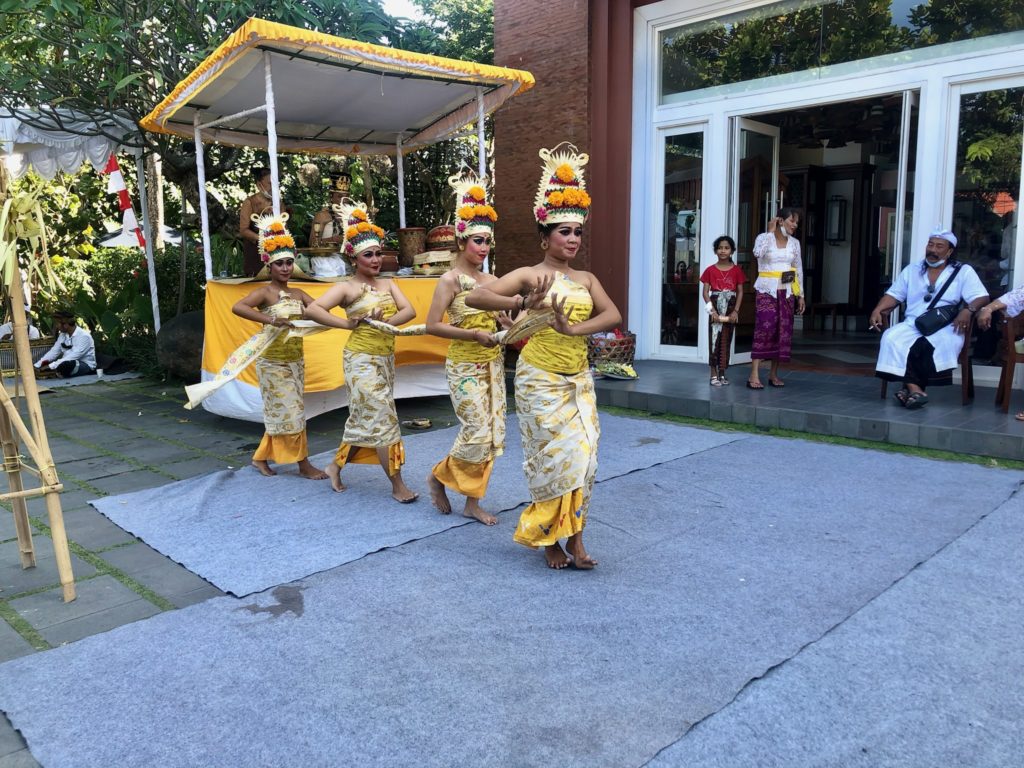
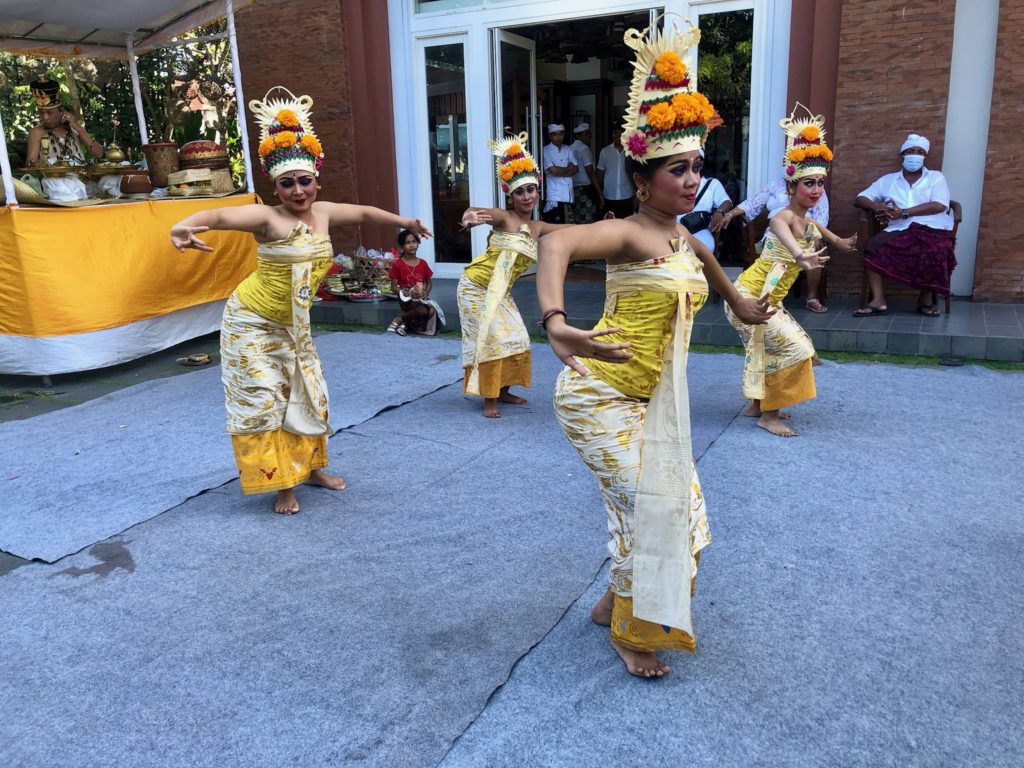
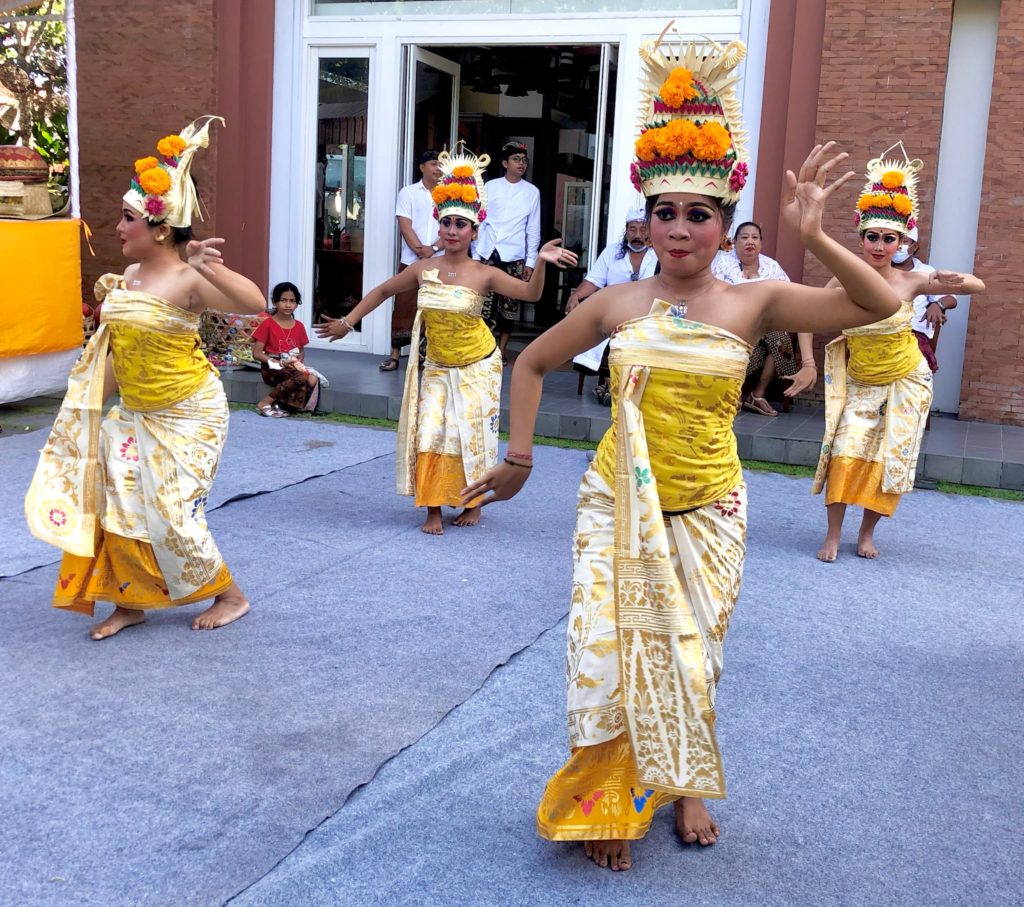
The legong dancers were the culminating event of this full moon ceremony. That is okay as there will be another round of purnama ceremonies at the next full moon.
Bali is a Never Ending Loop of “Say What!”
Life works, and works great, only we count on every unexpected miracle — serendipity events big and small. Here is another micro miracle. Recently, this writer was on the back of a motor bike with his girlfriend (pacar) driver. We were zipping around Ubud town, Bali’s chic-chic tourist mecca. He heard the oddest sound from the motorbike behind him. The writer turned around and had just enough composure to snap this picture:
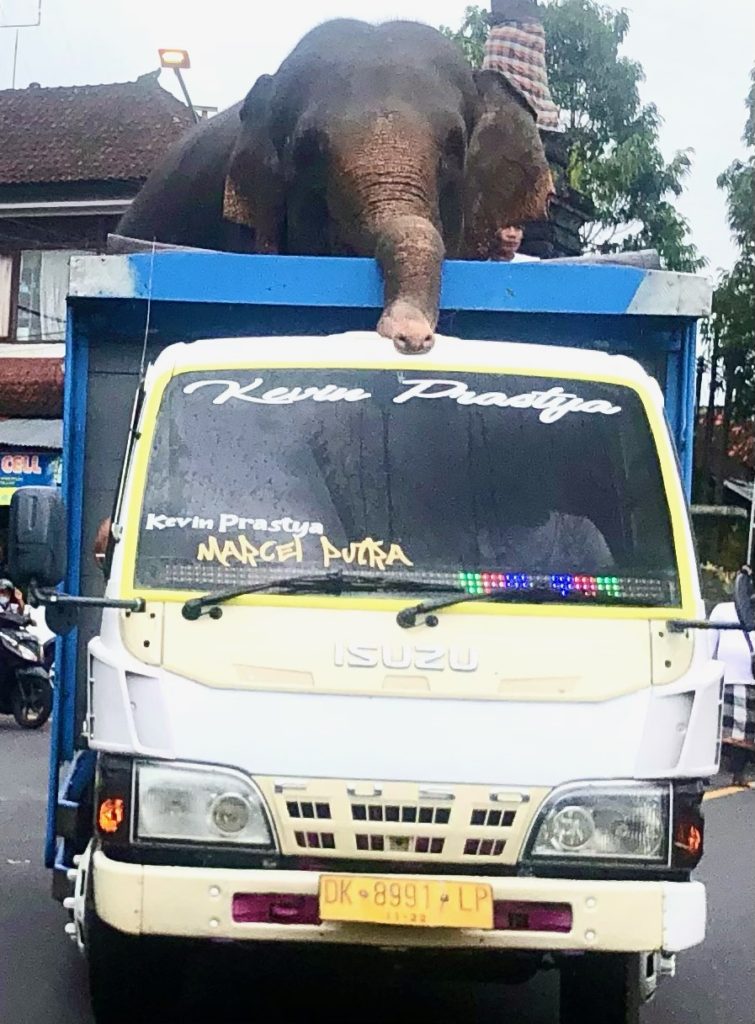
Now, That’s ”Bali Magic.”
Bonus: Beauty on the Beach
At the cremation, the beauty of the Balinese contrasted with the tourist energy of the passing bule (foreigner). What was this bule thinking about this scene as she passed by on her way to the beach?
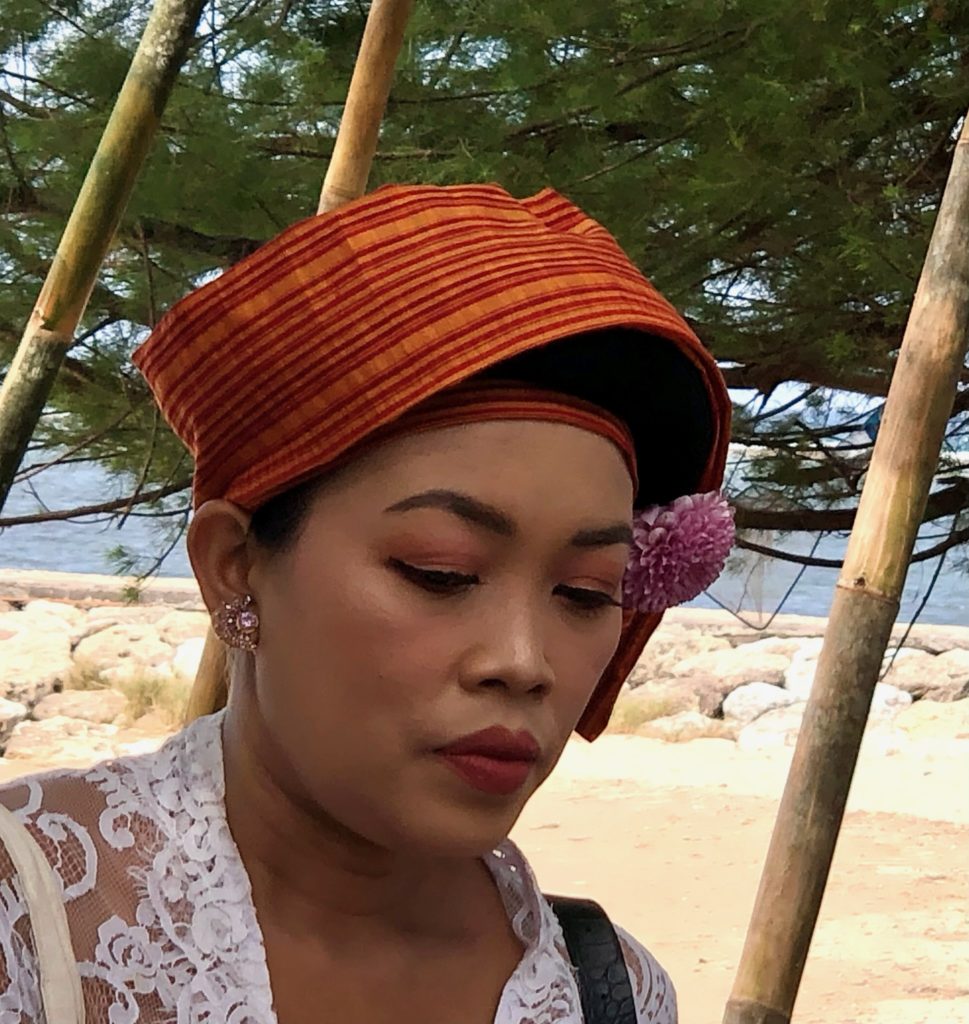
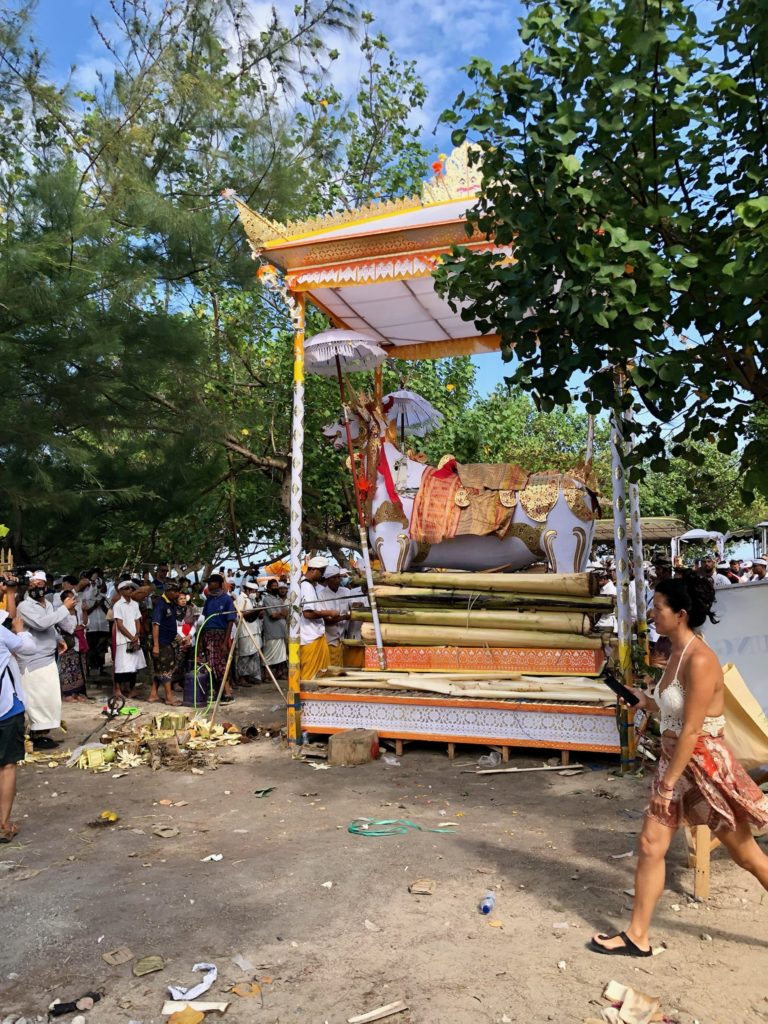
Shameless Plug. Please consider signing up for a FREE subscription to this website which is both a travelogue and literary journal. Notices of new postings will be sent to readers by email. If interested, please, SUBSCRIBE BELOW. Note: Your information will never be marketed, sold, or used in any way. The marketing of personal data is a horrible idea. It will never happen to readers enjoying this website.
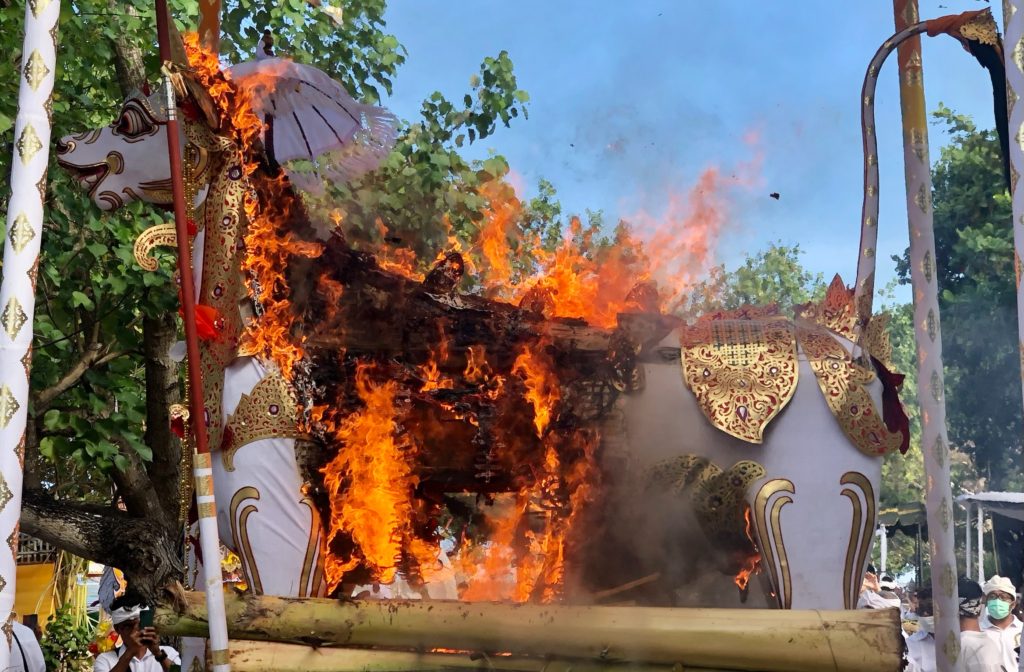
Very interesting! Thanks!
Dear Sir,
If you could kindly include the date of the postings it would be very much appreciated.
Sincerely,
Beaverton Bob
Thank you for the comment, Bob from Beaverton. In the Table of Contents, the date for each post is listed. Once the article is opened, that information is not carried over. I used to put the date upfront in the article text. I will include that information again from now on. I appreciate the suggestion. Zephyr Carlyle